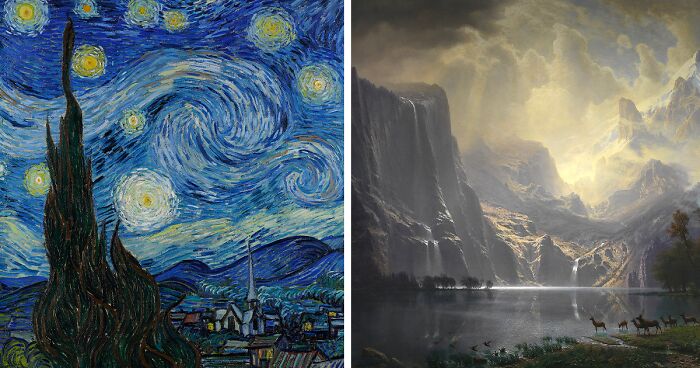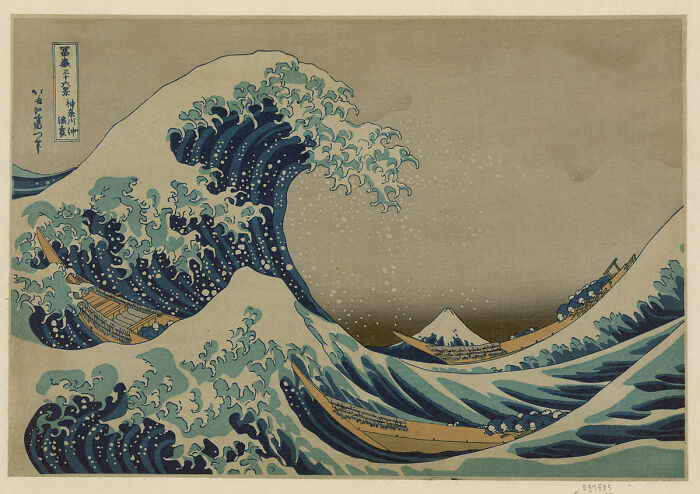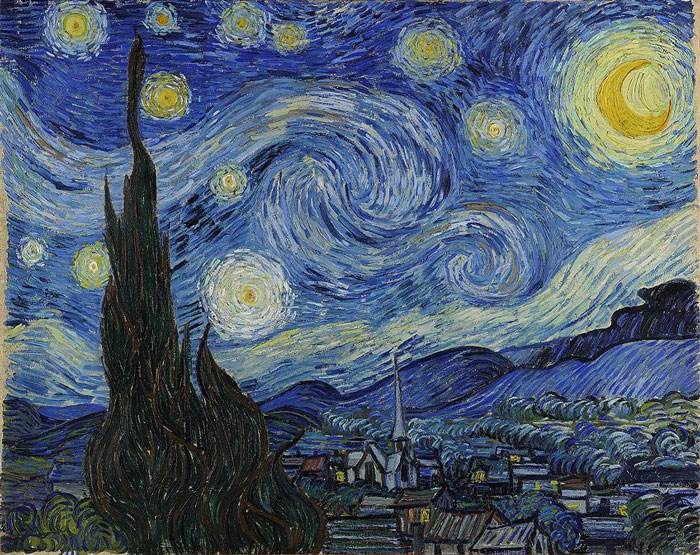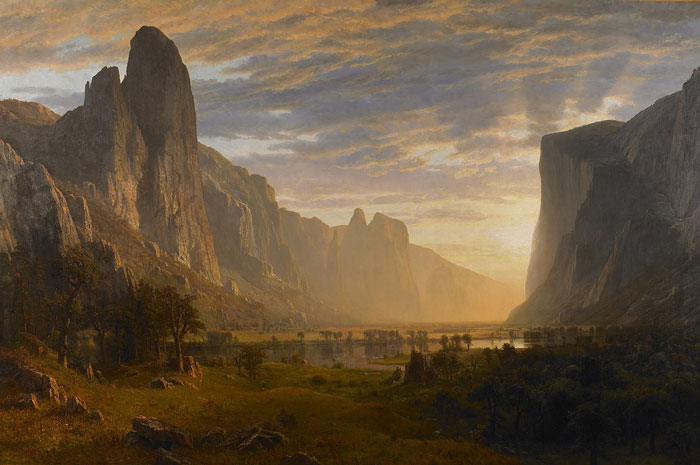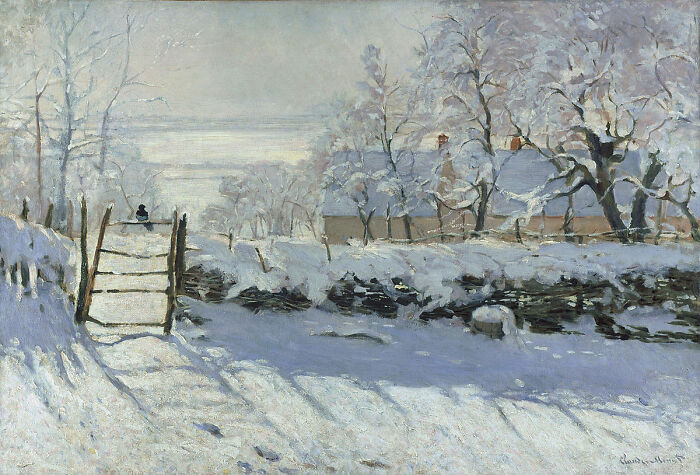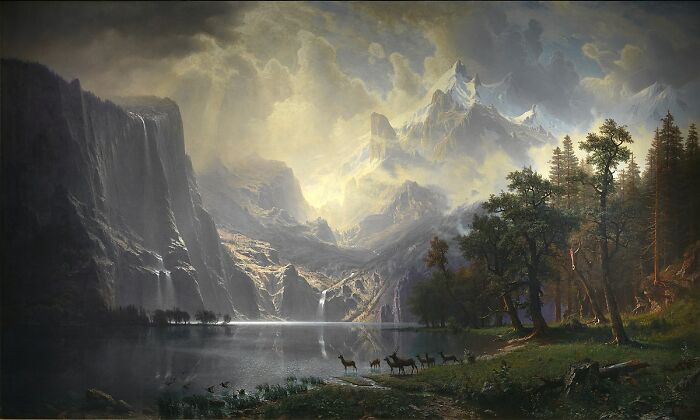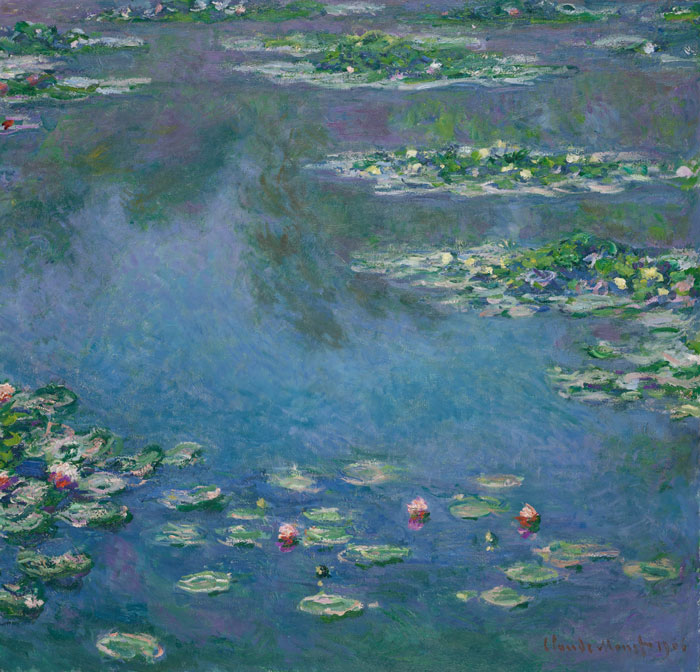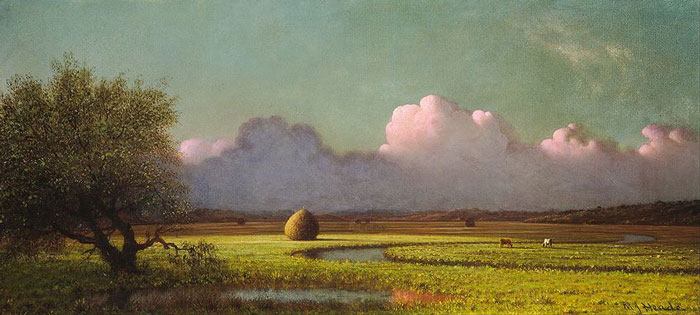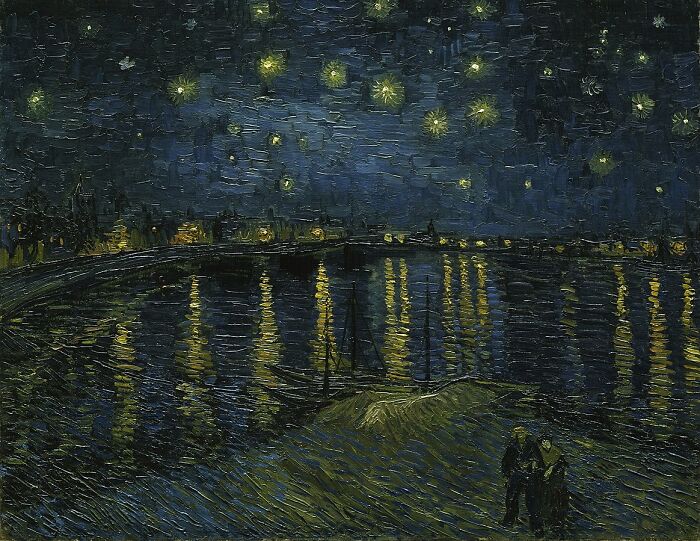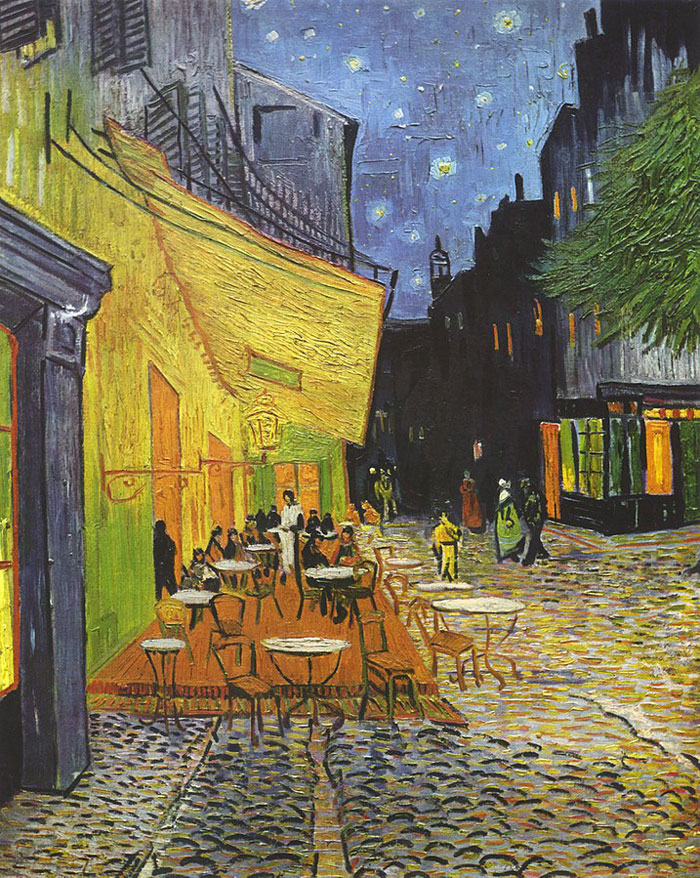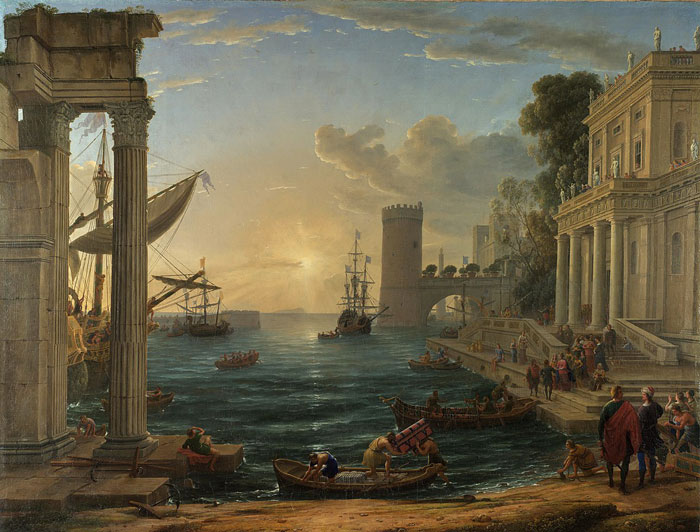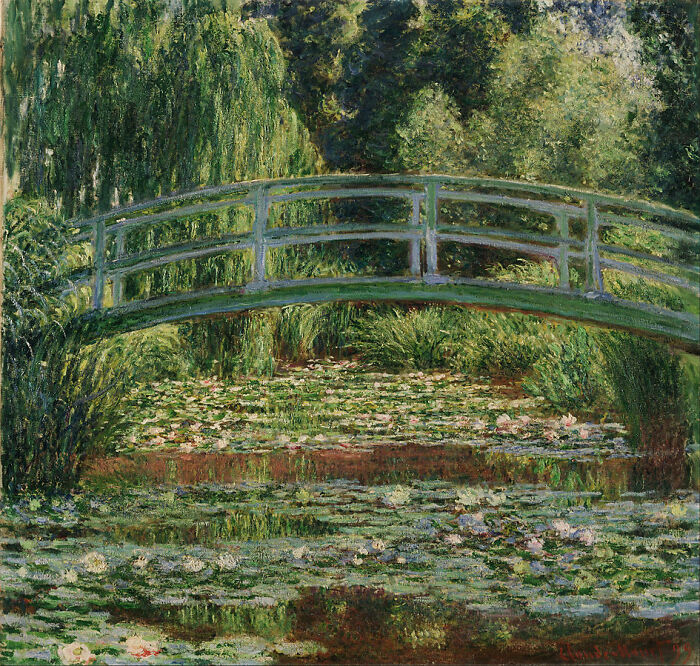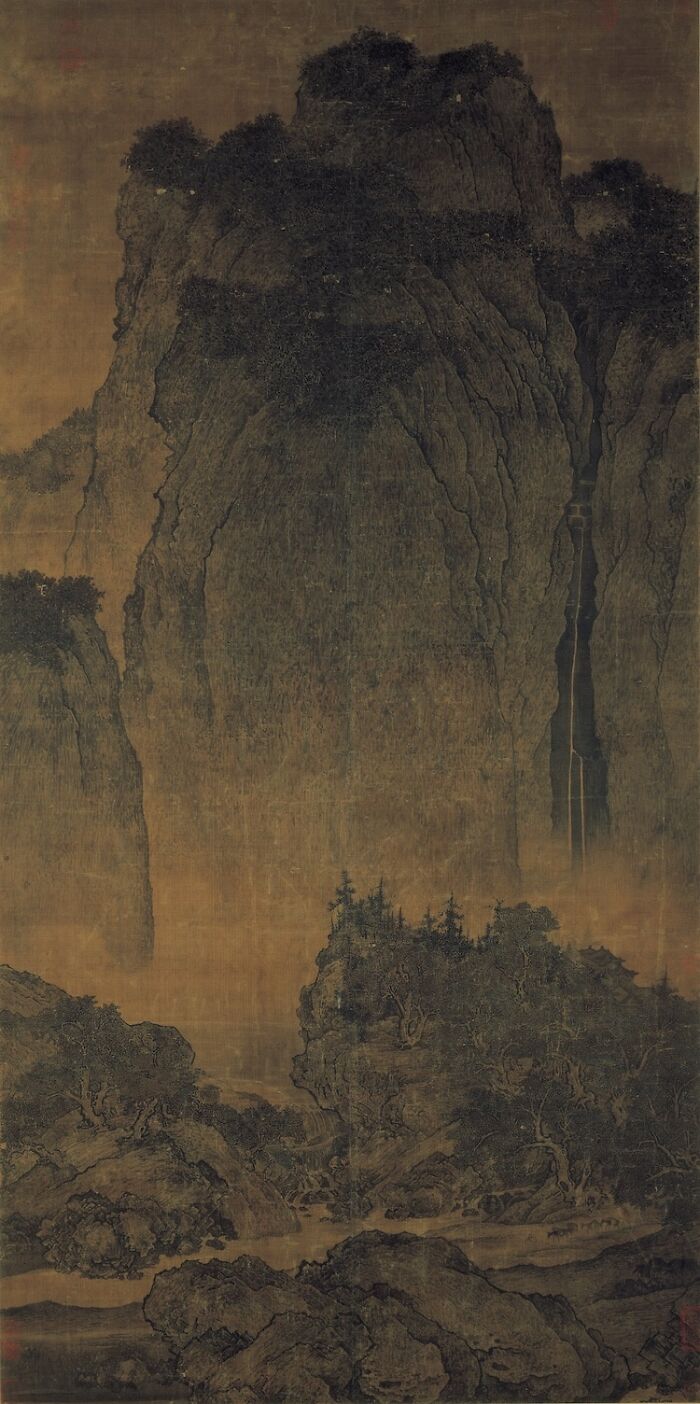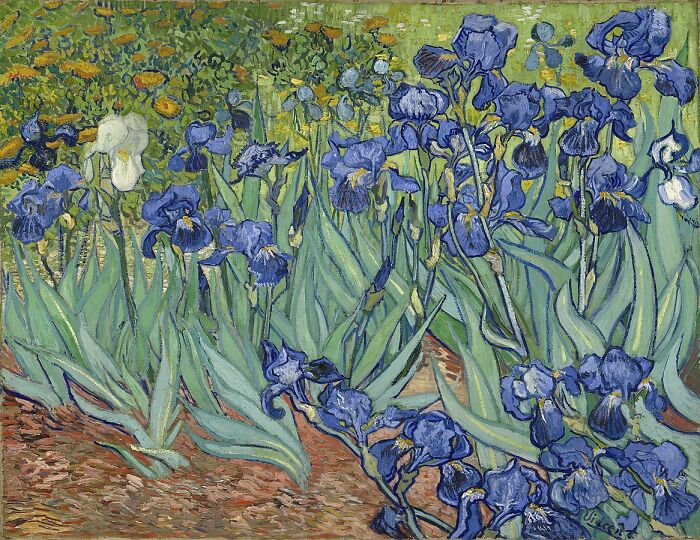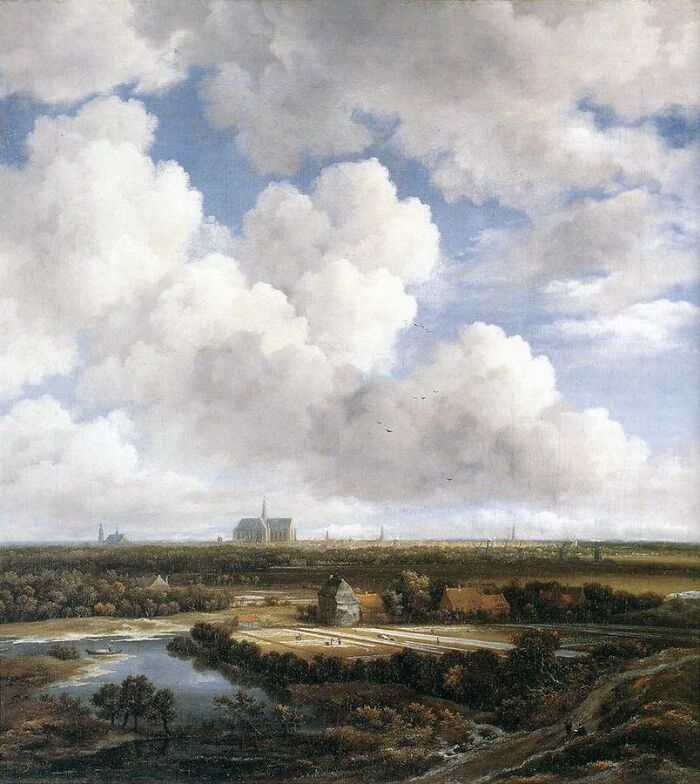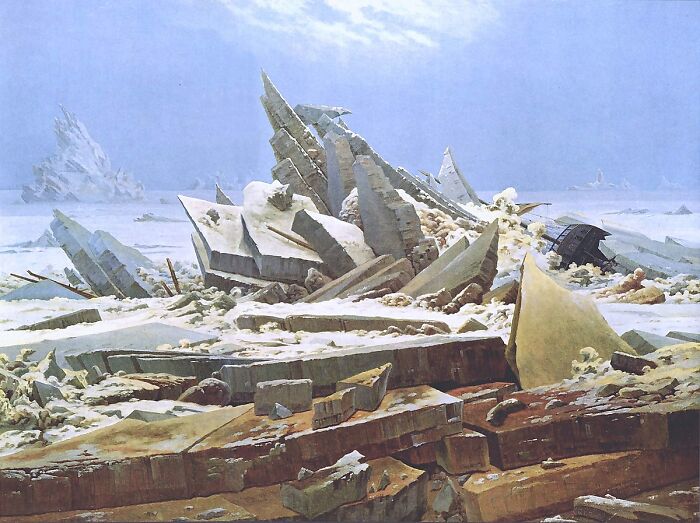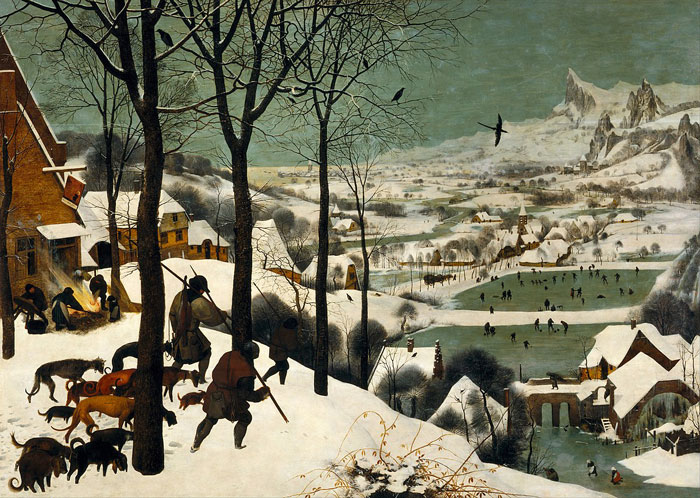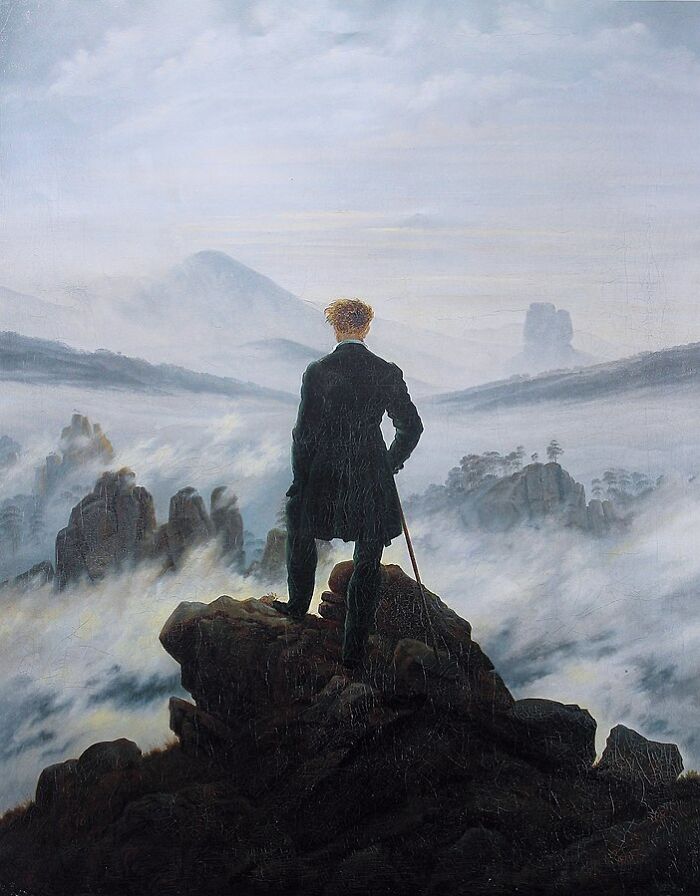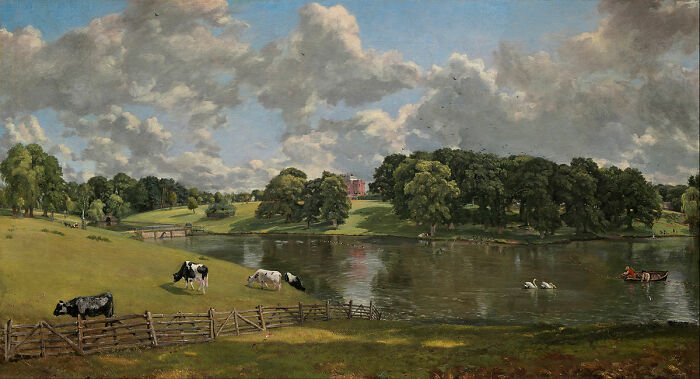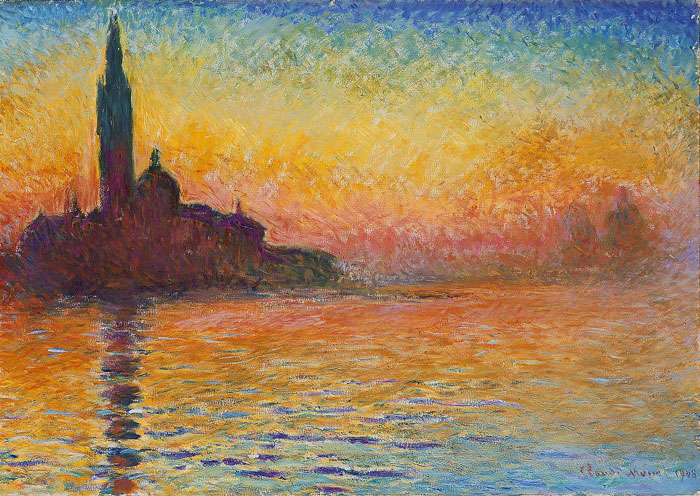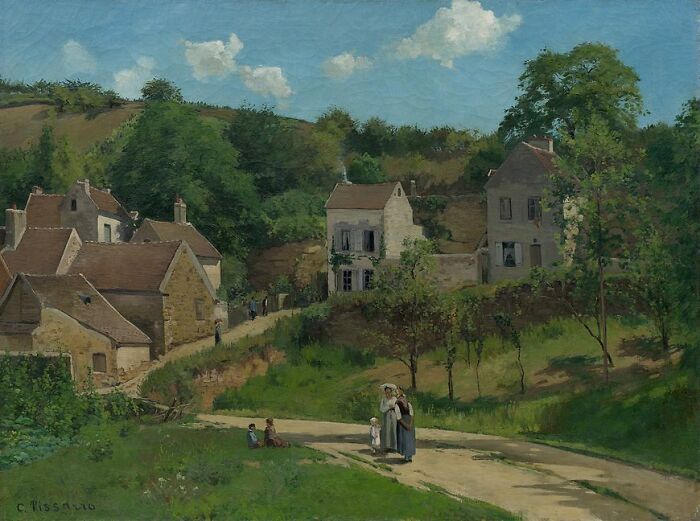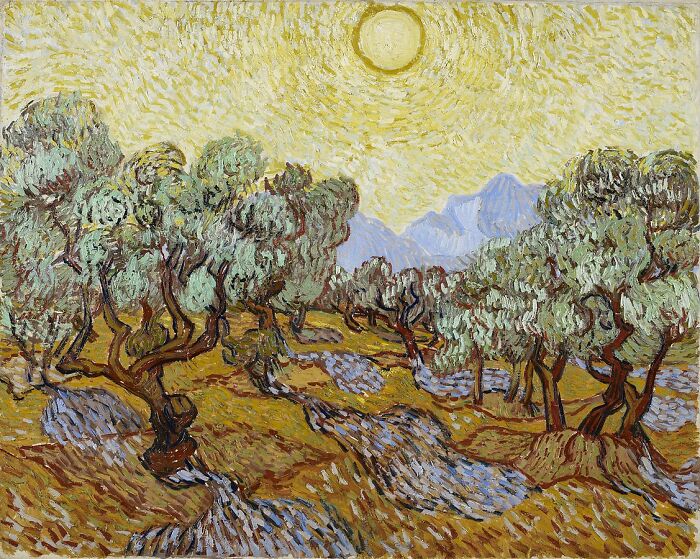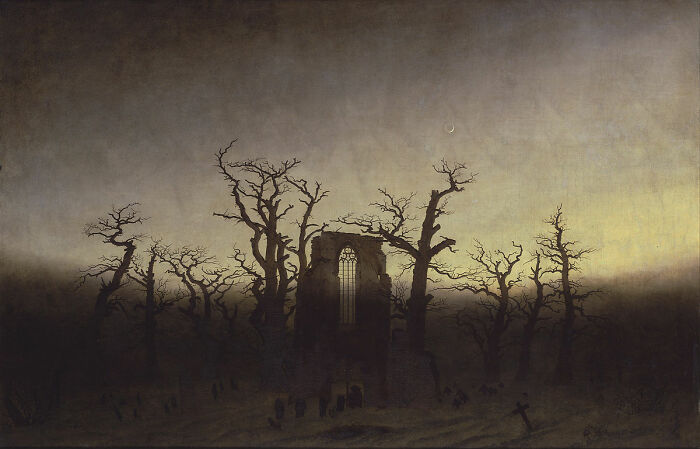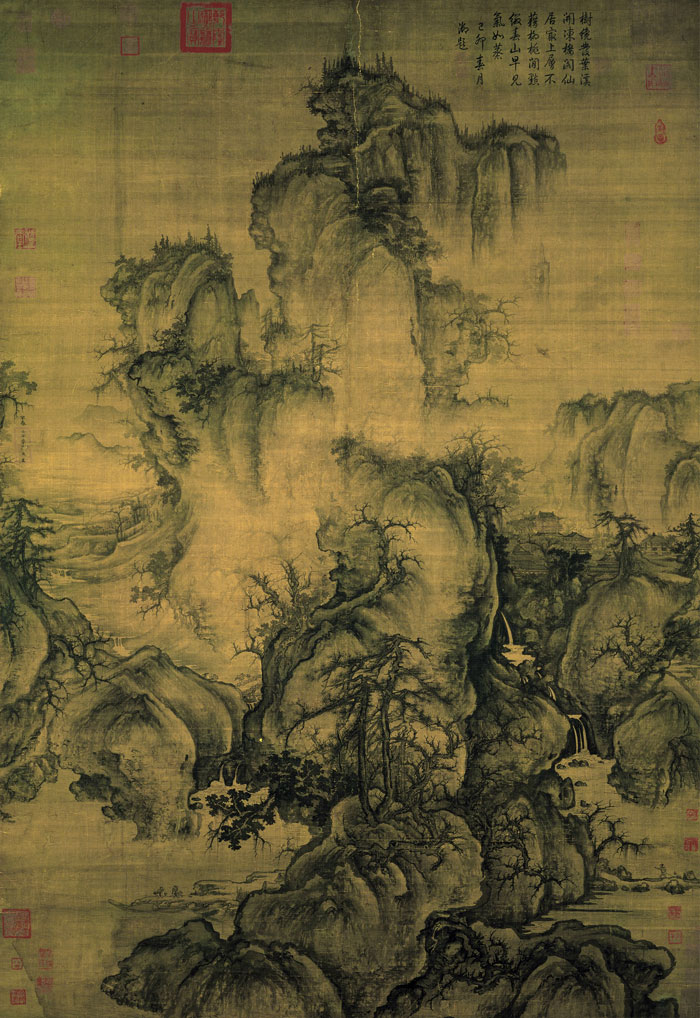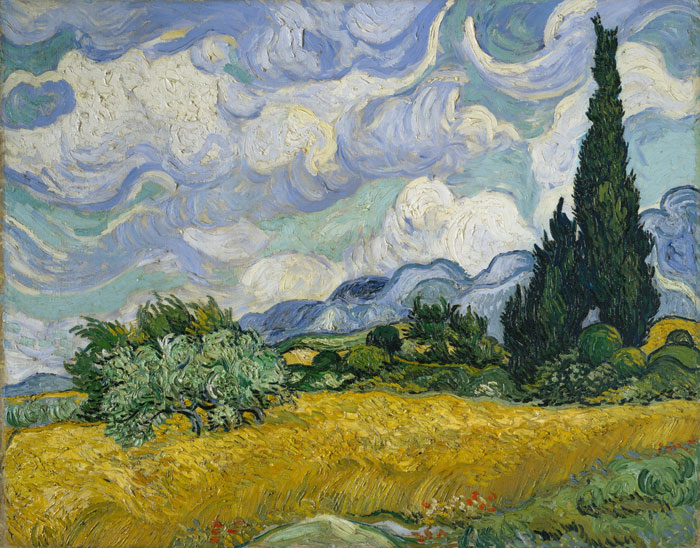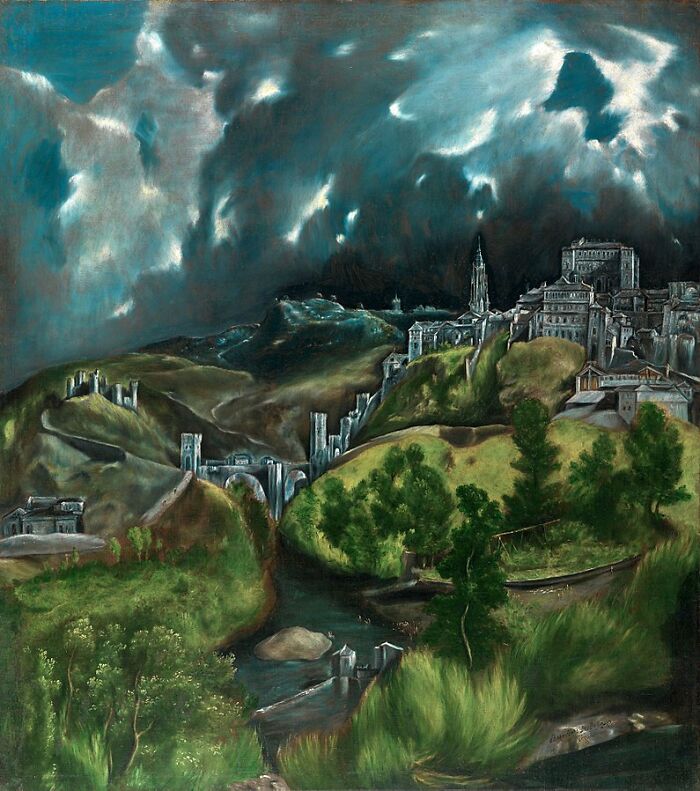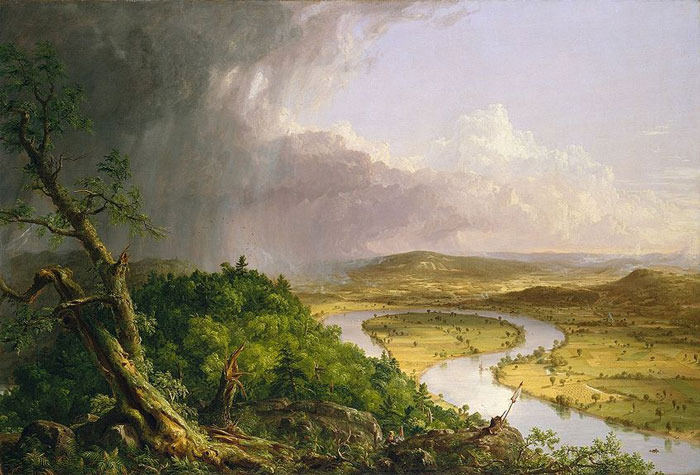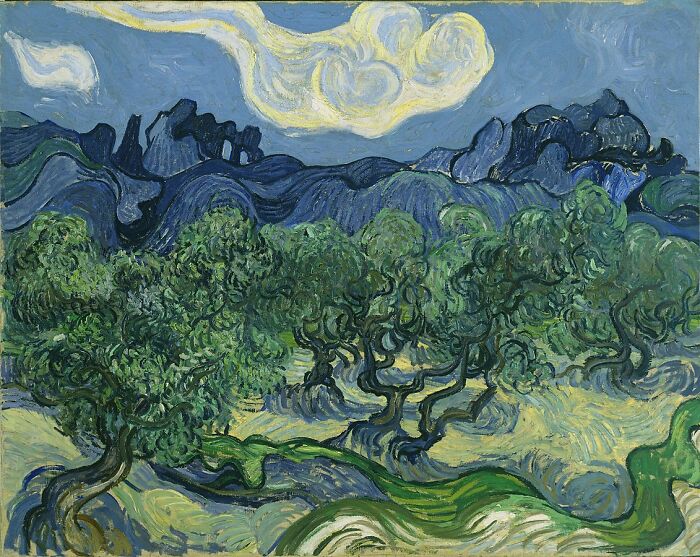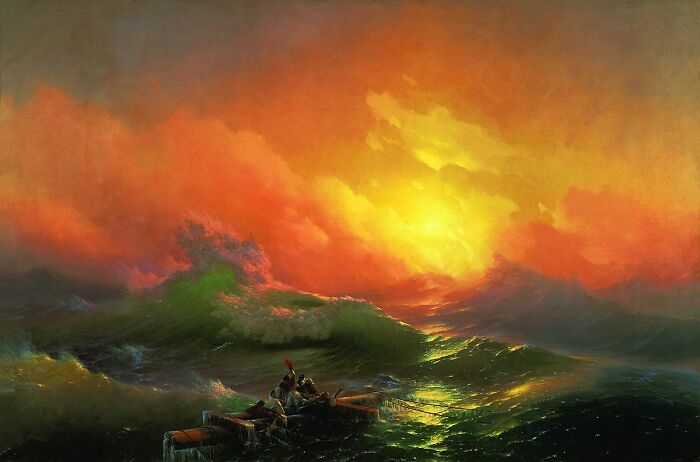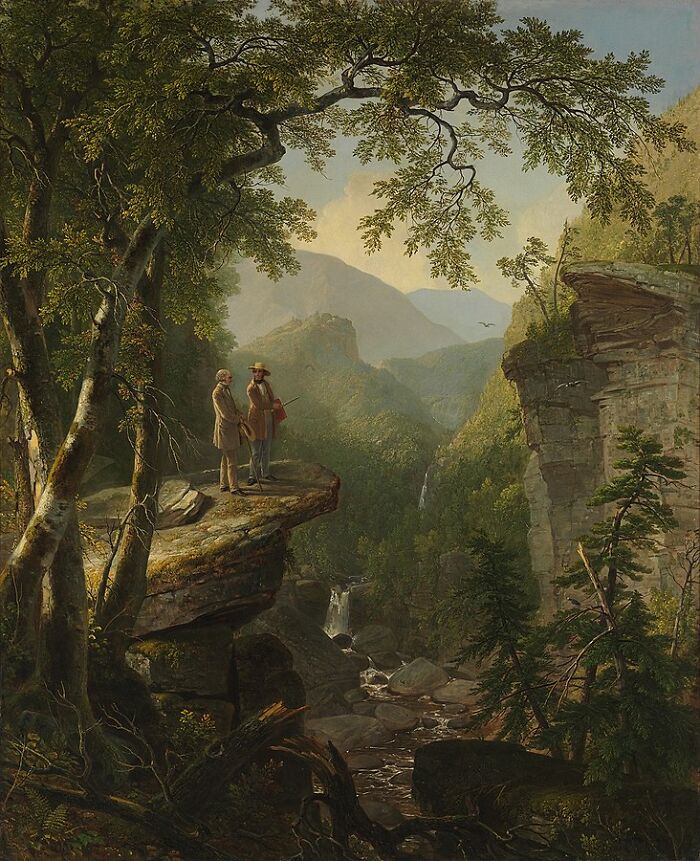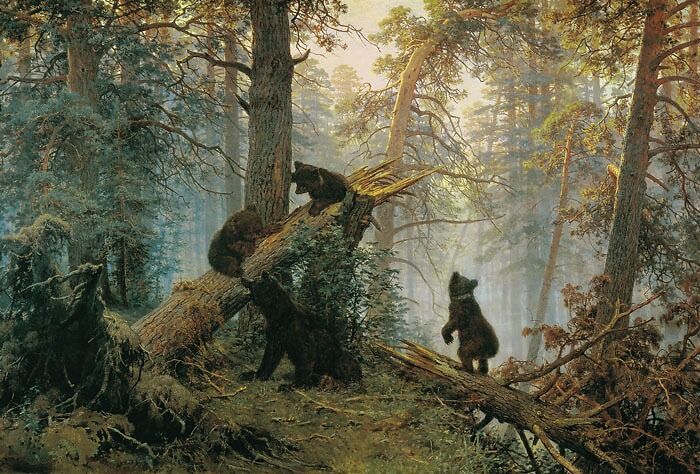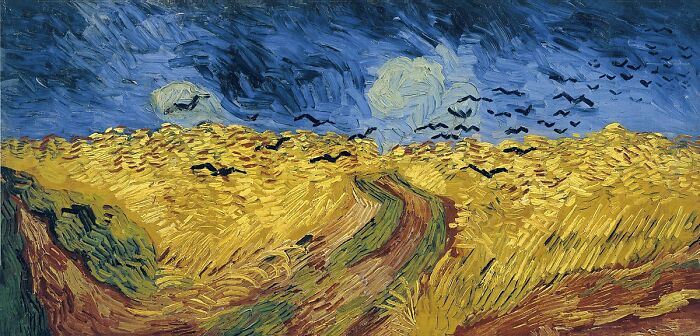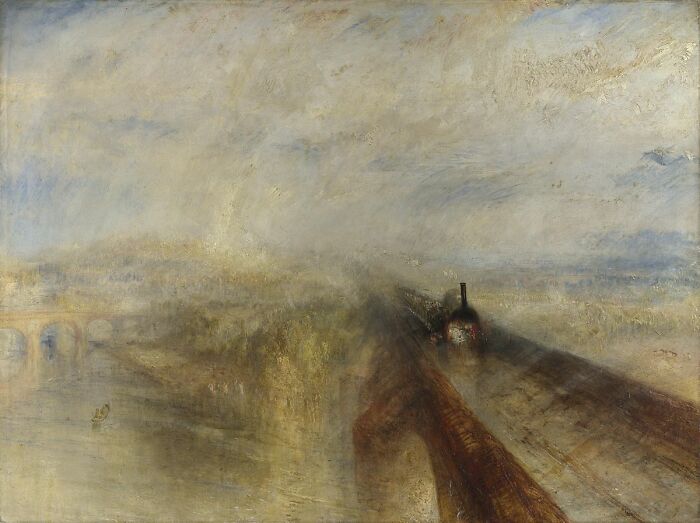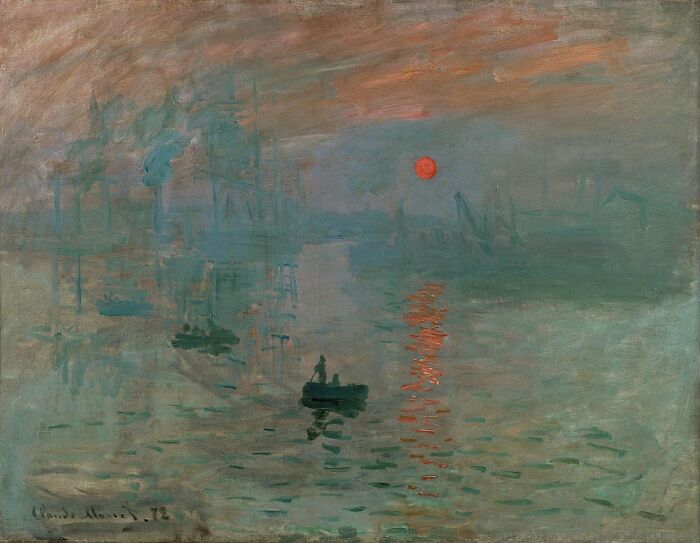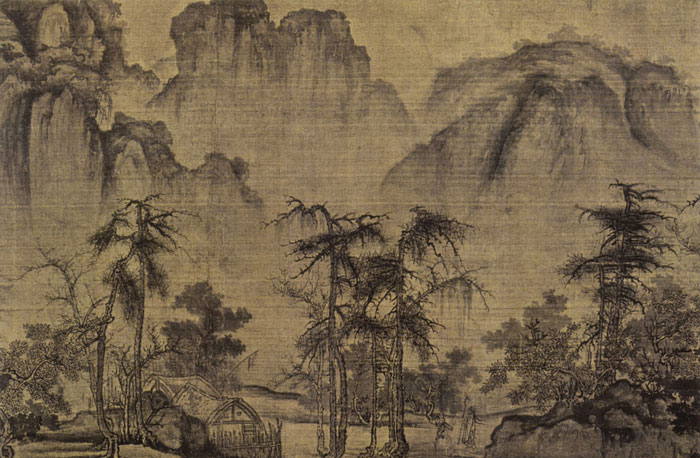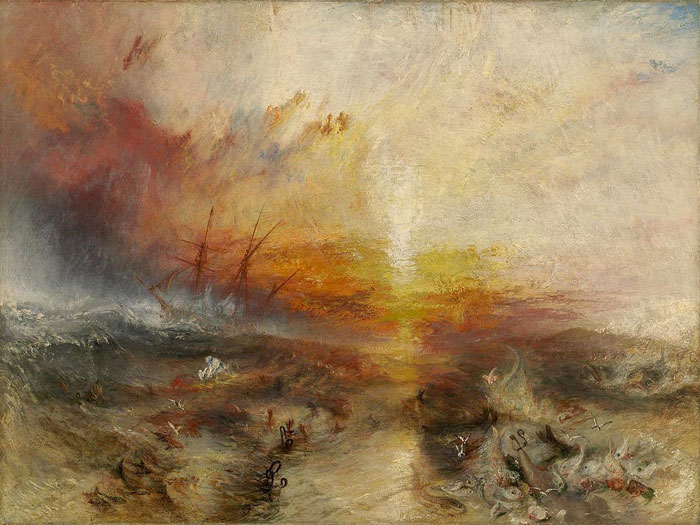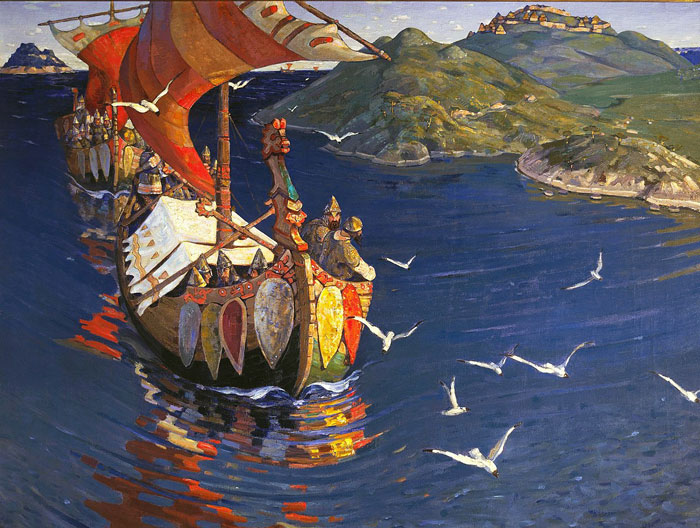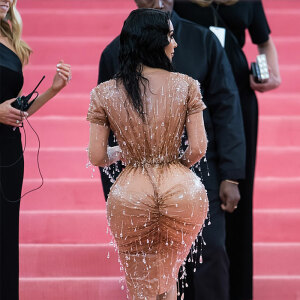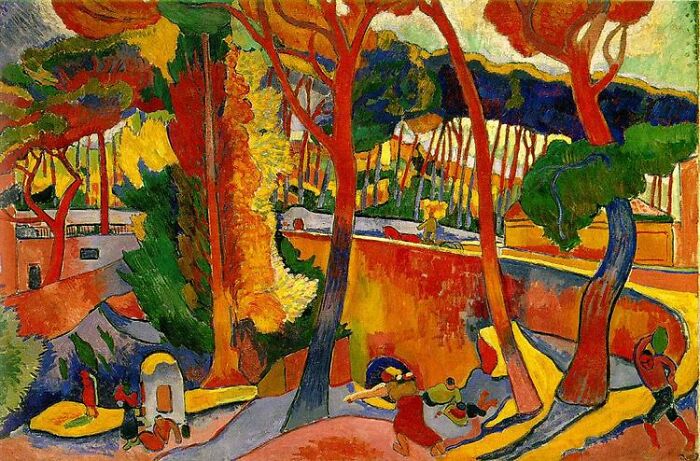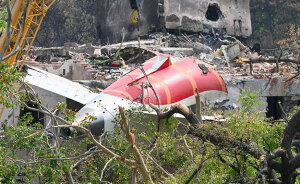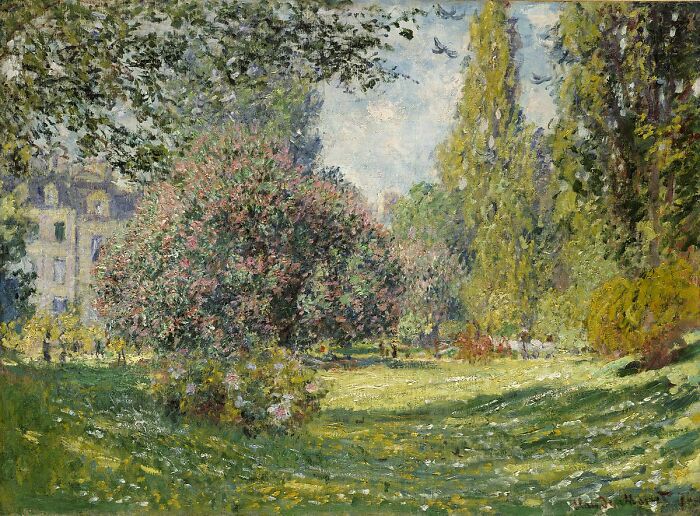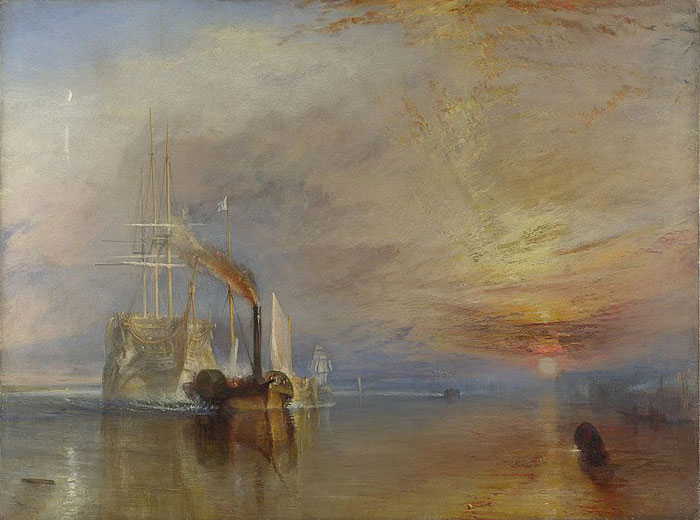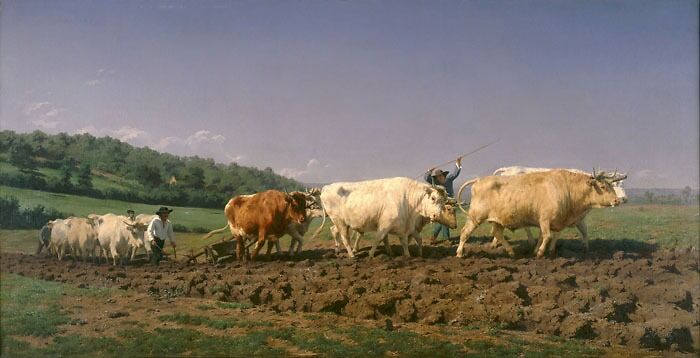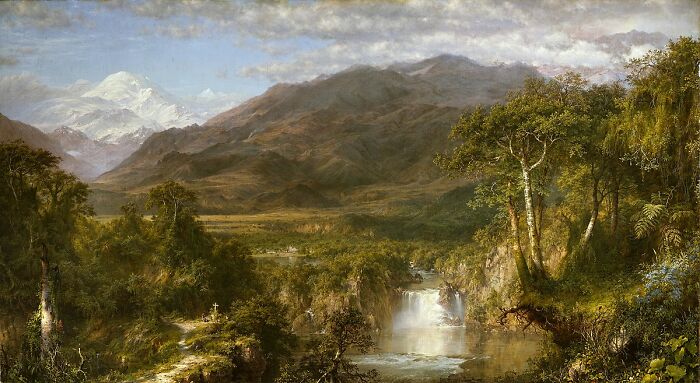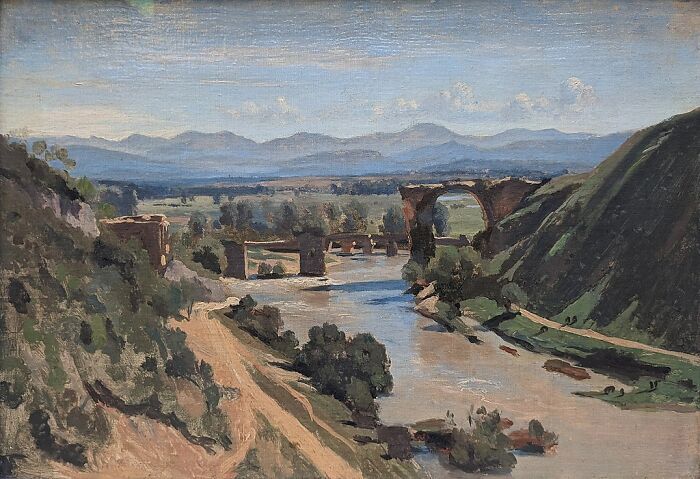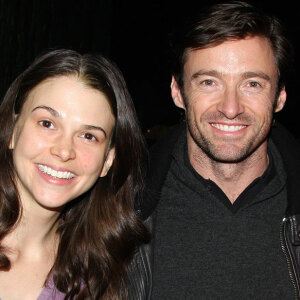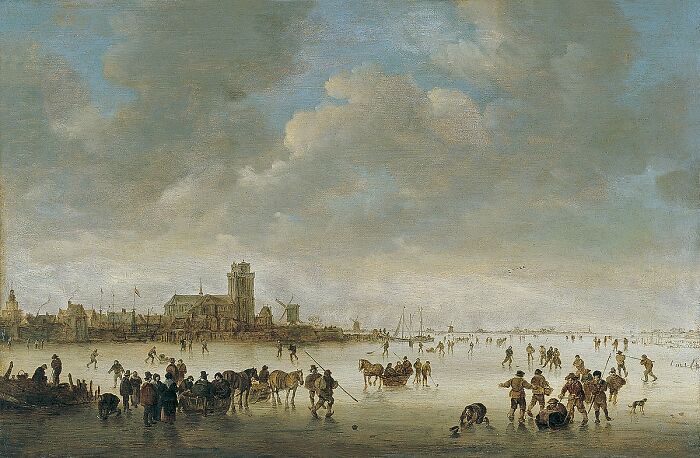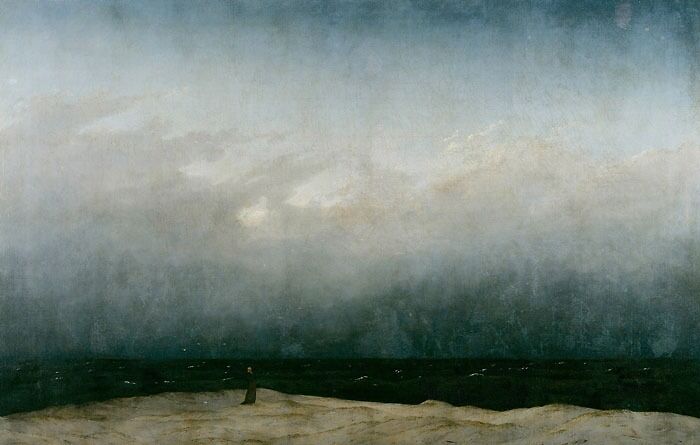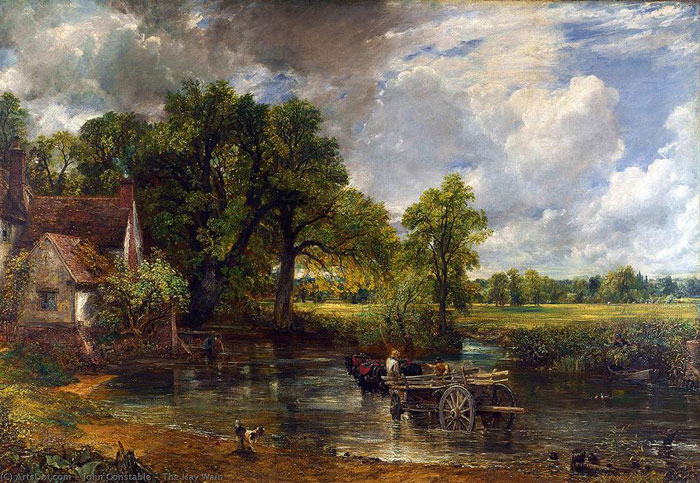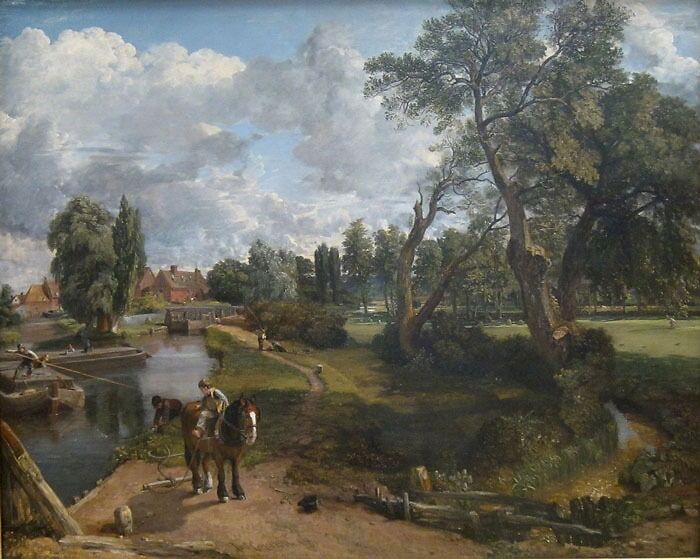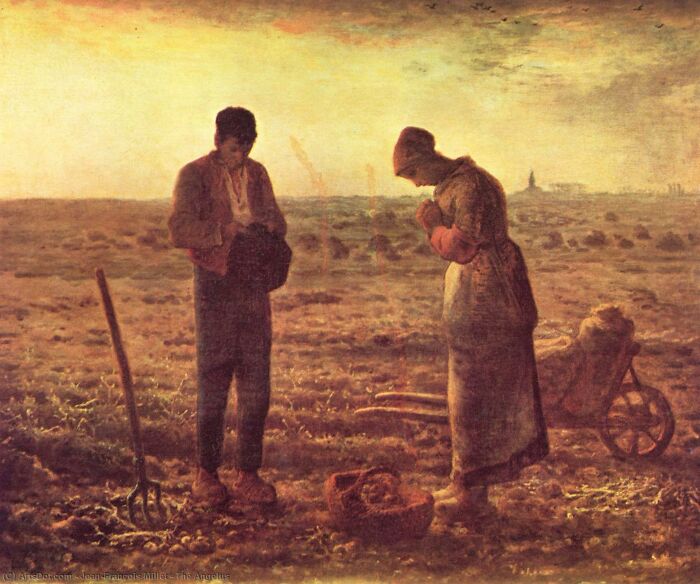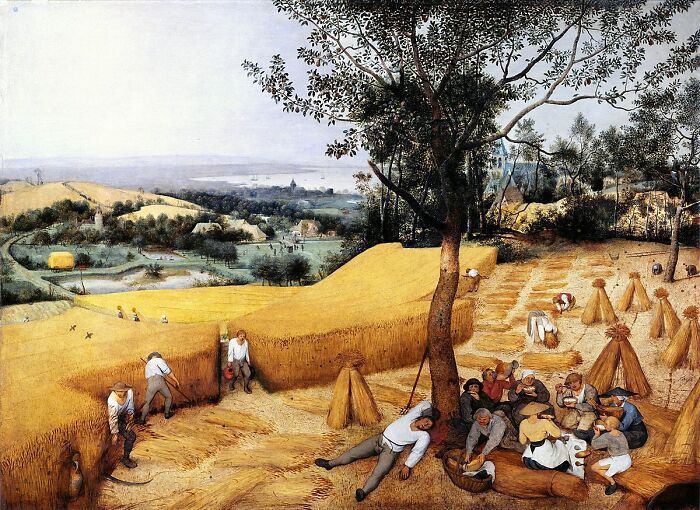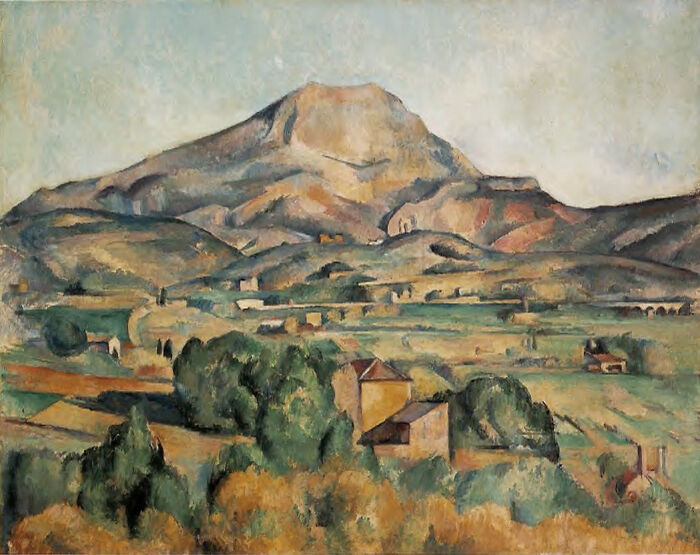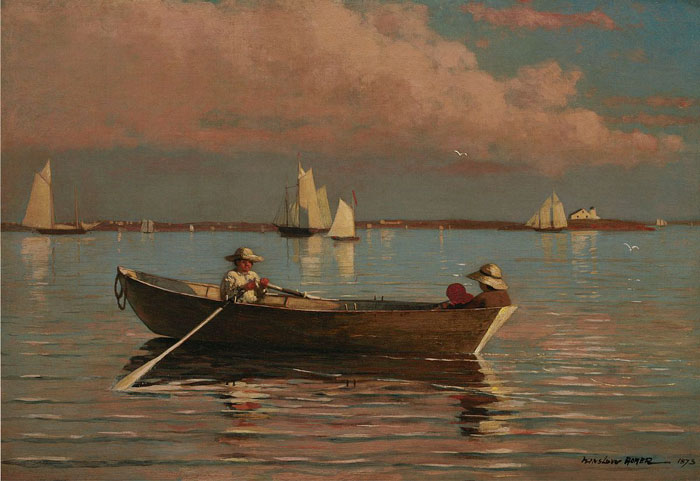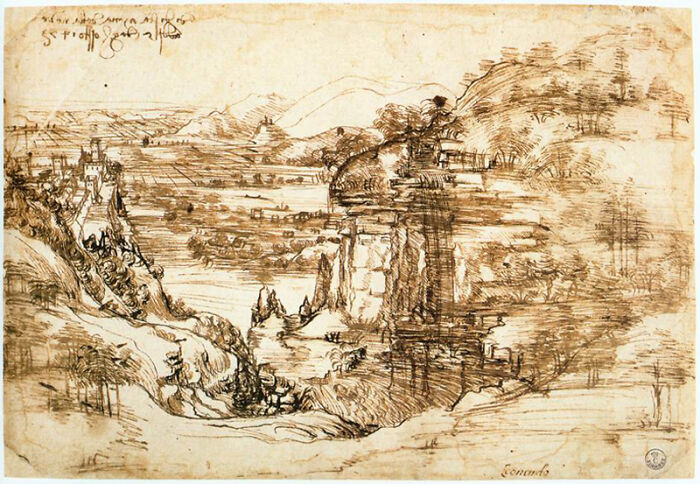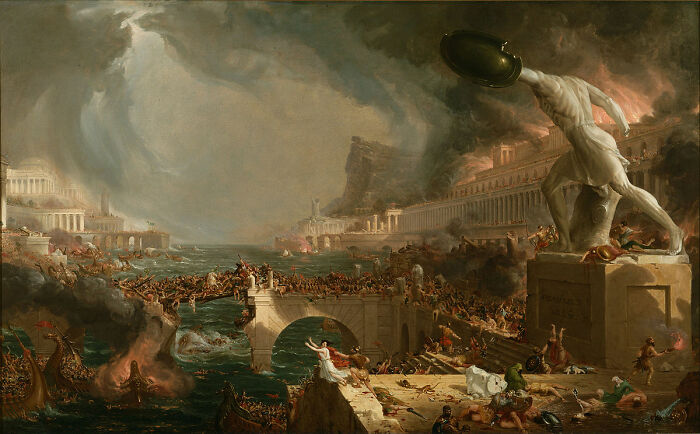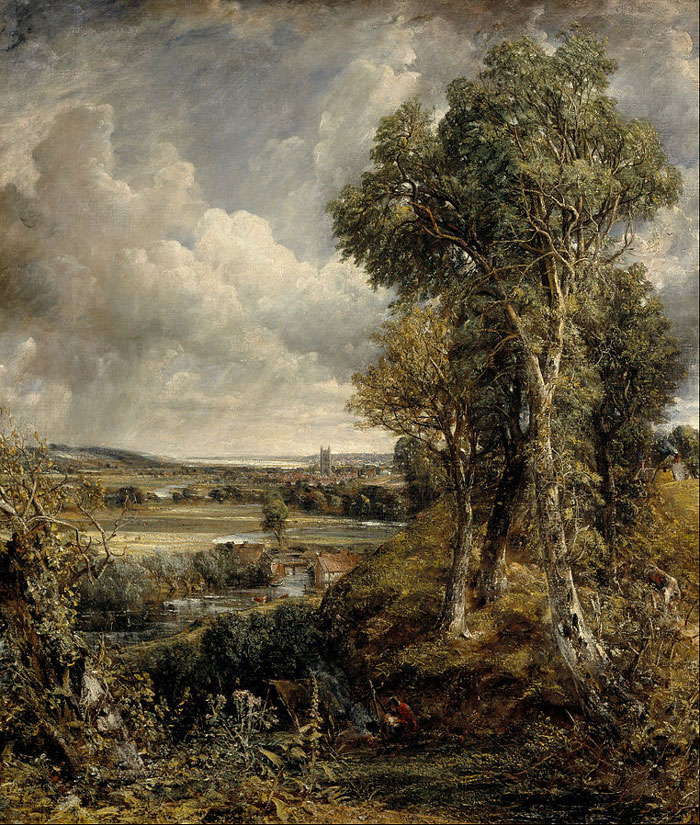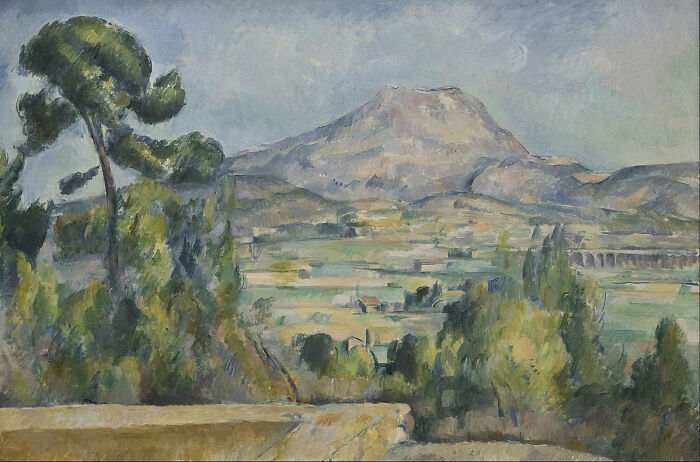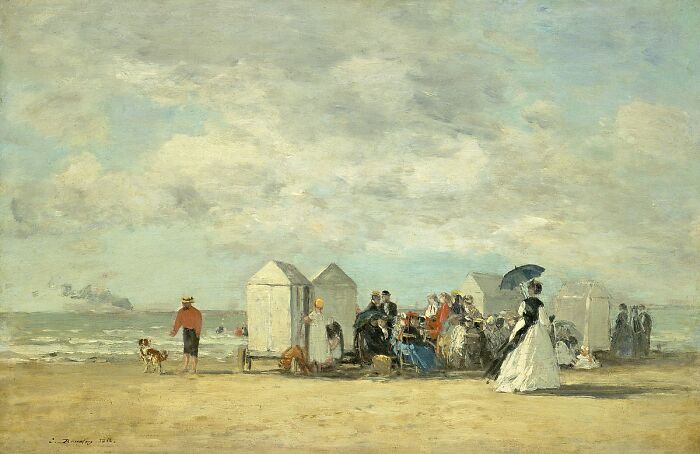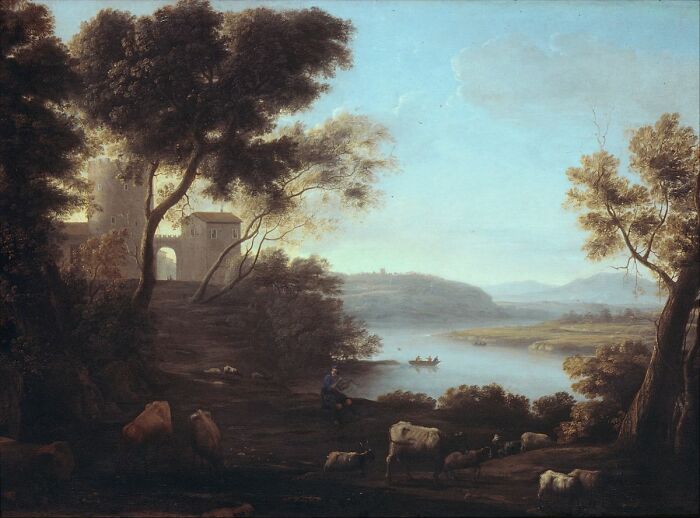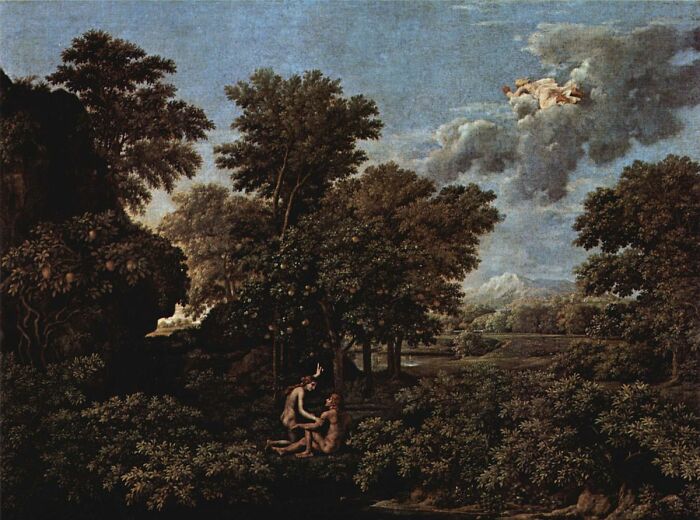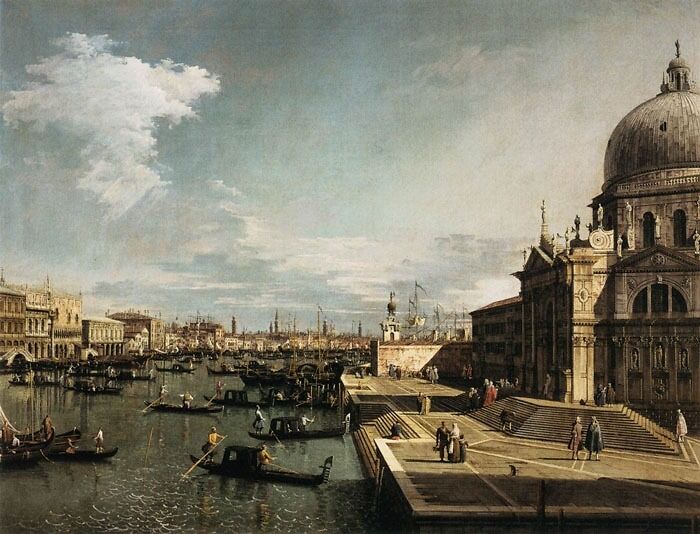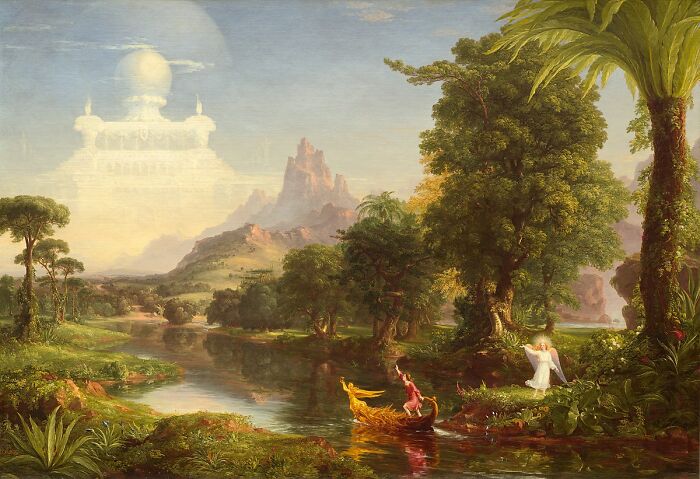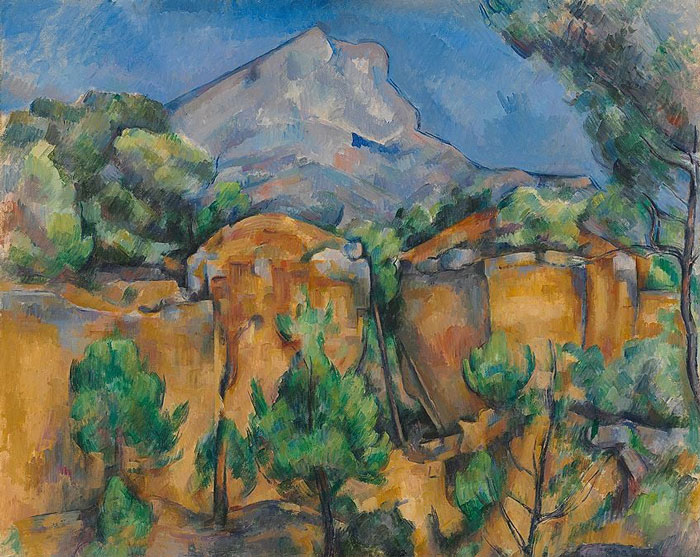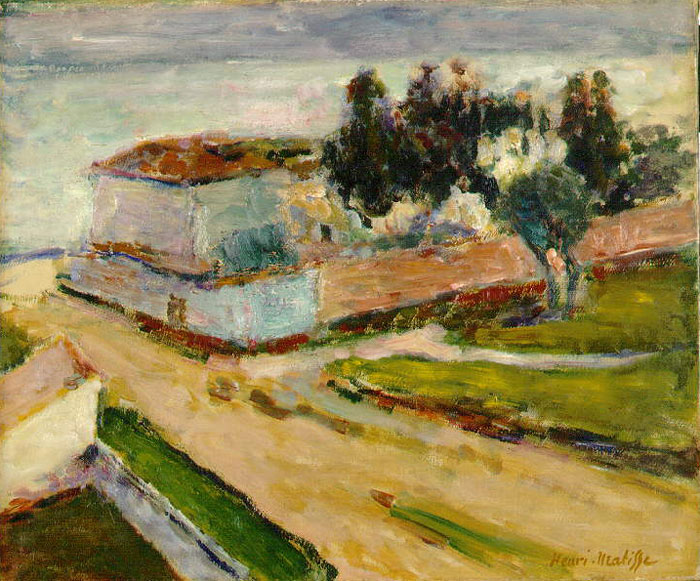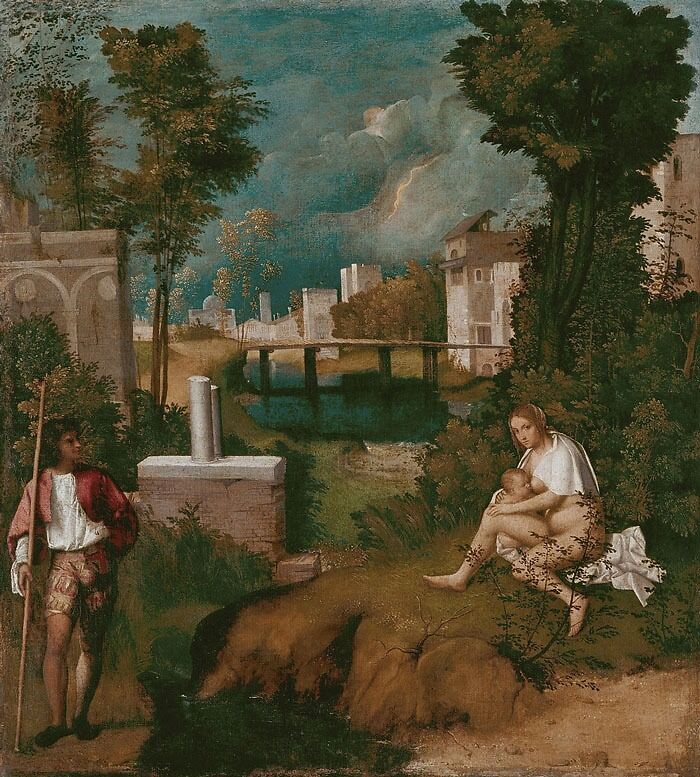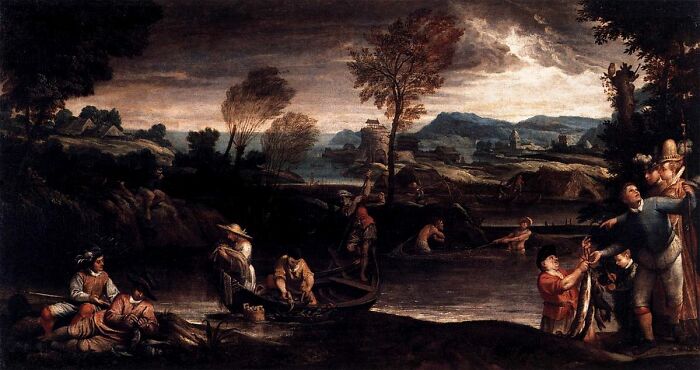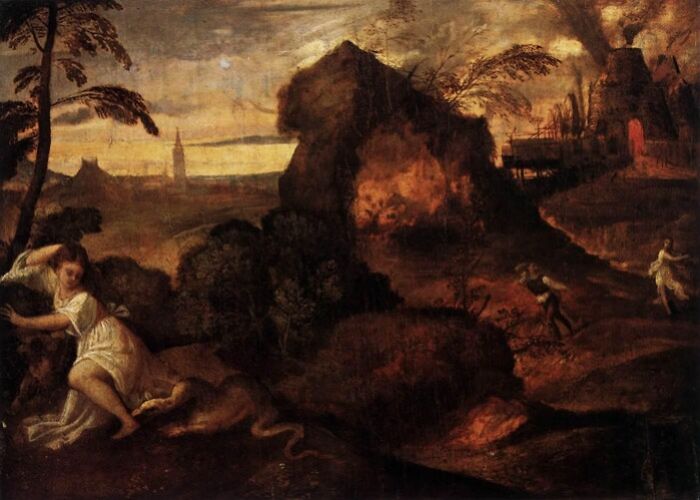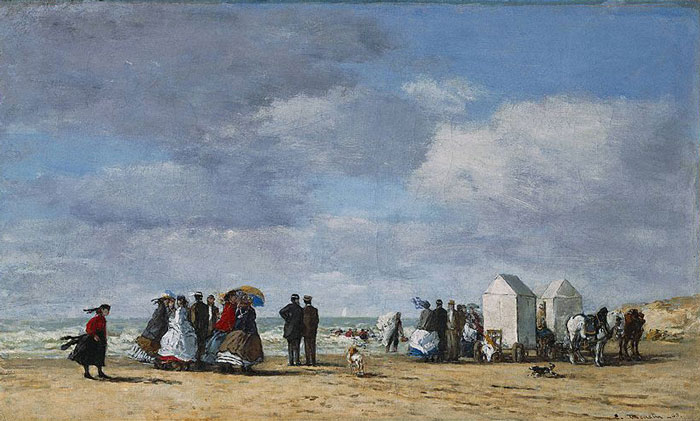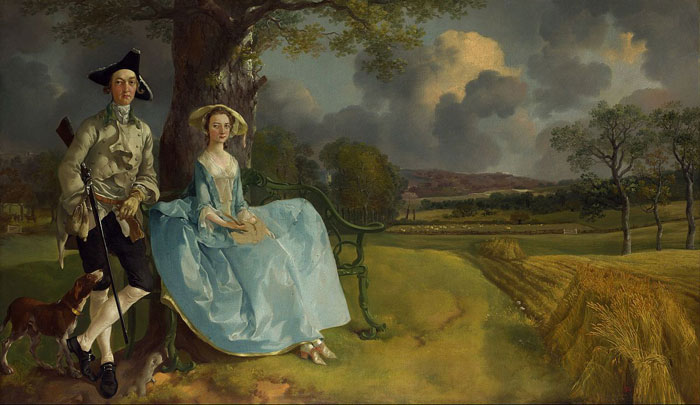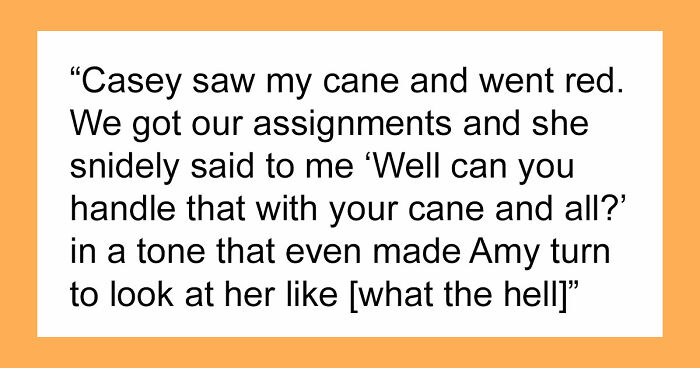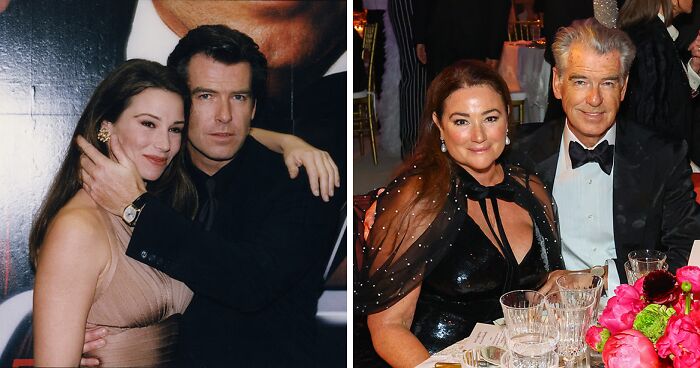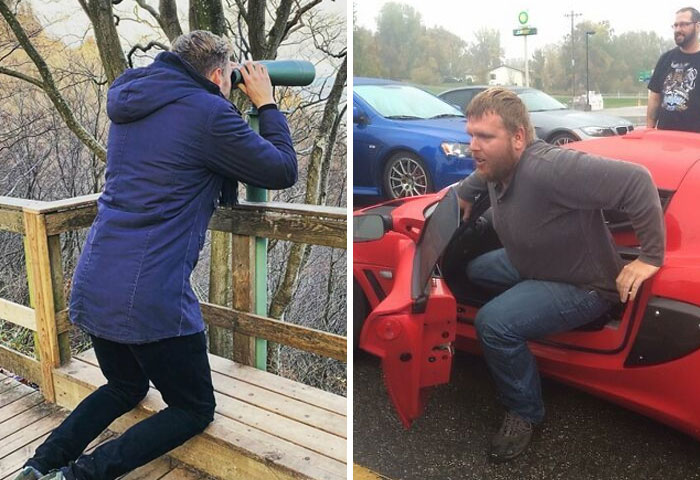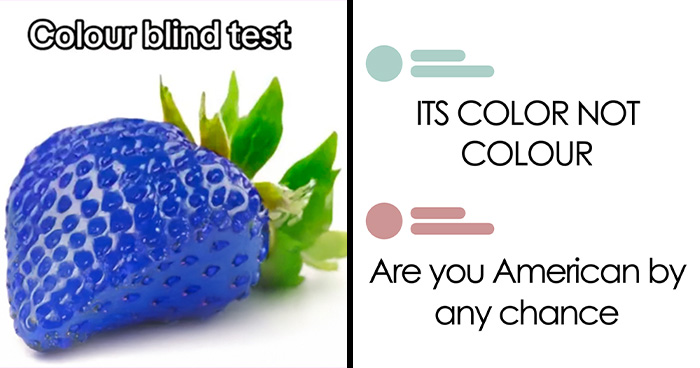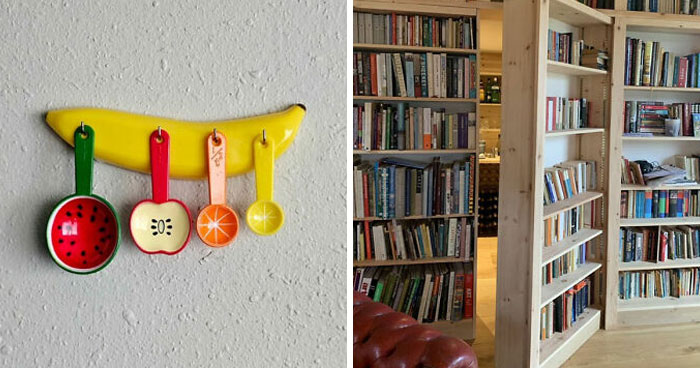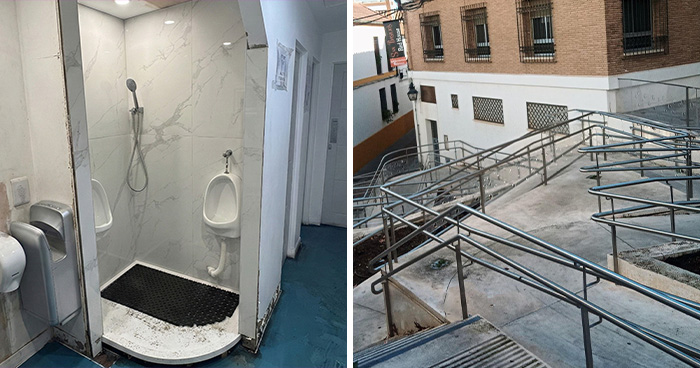There is much beauty to be found in the world around us. There is so much to enjoy on this Earth and see, yet so much is often left overlooked. From modern towns to wide-open ranges of nothing but nature, landscape painting attempts to capture it all. This style of painting gives a lot of room for creativity to go wild. Landscape paintings can capture a moment for what it is — a passing thing — and create an opportunity to enjoy the view.
All works of creativity are just fruits of the mind and painted landscapes sometimes feel surreal, blending elements of reality and fiction. We can see the world from a different perspective through these artistic creations. Some of history’s most famous artists have mastered combining natural scenery with man-made structures or emotional human elements, creating a harmonious balance between nature and humanity.
From desolate buildings to love-infused couples, the greatest landscape paintings seamlessly integrate multiple elements, offering a rich, multi-layered viewing experience that transcends reality while grounding us in familiar emotions and scenes.
If you are out looking for a drop of inspiration, look no further than the paintings of famous landscapes below, one after another, and high chances are that those landscape painting ideas will start planting seeds in your head, too. If one of the paintings ignited your creative light, be sure to upvote it. If you have more to add about the painting, comment below and share what you know.
This post may include affiliate links.
The Great Wave Off Kanagawa
Artist: Katsushika Hokusai | Year (completed): 1831 | Period: Impressionism
The Great Wave Off Kanagawa might be one of the most famous Japanese paintings, which has a following even in the western hemisphere. It shows how huge waves are about to crash into some fishermen and their boats. In the background, the mountain Fuji is peaking out and acts like a northern star.
The Starry Night
Artist: Vincent Willem van Gogh | Year (completed): 1889 | Period: Post-Impressionism
The night sky, packed with stars and the moon, takes up most of this medium-sized oil painting on canvas. It occupies three-quarters of the picture plane and is characterized by strongly swirling patterns that seem to wash across its surface like waves. It also appears tumultuous, almost agitated. It is encircled by concentric circles of radiant white and yellow light and is pocked with luminous orbs, including the crescent moon to the far right and Venus, the morning star, to the left of the center.
Looking Down Yosemite Valley, California
Artist: Albert Bierstadt | Year (completed): 1865 | Movement: Hudson River School
It was Bierstadt's first substantial depiction of Yosemite, a subject for which he would later gain notoriety. It offers a glimpse of one of America's most picturesque locations. Based on sketches he did in 1863, Bierstadt depicted the valley from a viewpoint above the Merced River, gazing west with Sentinel Rock and El Capitan enclosing the view on the right and left, respectively. In the distance, Middle Cathedral Rock's spire may be seen.
The Magpie
Artist: Claude Monet | Year (completed): 1869 | Period: Impressionism
The Magpie's canvas shows a lone black magpie perched on a gate fashioned from a wattle fence as the sunbeams touch newly fallen snow, casting blue shadows. One of Monet's earliest uses of colored shadows, which subsequently came to be linked with the Impressionist movement, may be seen in this picture.
Among The Sierra Nevada Mountains
Artist: Albert Bierstadt | Year (completed): 1868 | Style: Luminism
The painting features craggy mountains on the left and a luminous sky with the Sun's rays peeping through the clouds in the background. On the right side of the painting, there is a peaceful lake with a group of deer and waterfowl on the edge of a mountain. If you have a careful eye, you might have spotted a trout in the water on the left, in the shade of a rock.
Water Lilies
Artist: Claude Monet | Year (completed): 1906 | Movement: Impressionism
Claude Monet had completely abandoned the horizon line by the time he created Water Lilies. The artist glanced down, concentrating just on the pond's surface with its cluster of vegetation floating in the reflection of sky and trees, in this spatially ambiguous work. Monet produced the representation of a horizontal surface on a vertical one.
Sunlight And Shadow: The Newbury Marshes
Artist: Martin Johnson Heade | Year (completed): 1875 | Style: Luminism
Sunlight and Shadow painting tries to engulf its viewer with some beautiful shots of nature. Every small detail adds up to make a wonderful landscape — the creek coming from the right to the middle of the painting, the pinkish clouds above, the trees, and the haybales. But the most important part is played by the sunlight and shadows, opposite things that work perfectly together.
Starry Night On The Rhone
Artist: Vincent Willem Van Gogh | Year (completed): 1888 | Period: Post-Impressionism
Van Gogh painted Starry Night Over the Rhone on the bank of the Rhône, which was just a short distance from the Yellow House on the Place Lamartine, where he resided. Some of his more well-known works, notably The Starry Night, the most well-known Van Gogh painting of night stars, were inspired by the night sky and the effects of lighting.
As a Dutchie I'm kinda proud we had sucg a master in our midst, however, Vicent himself didn't really benefit much of his success when living... His work is always recognizable, that's for sure ;)
Cafe Terrace At Night
Artist: Vincent Willem Van Gogh | Year (completed): 1888 | Period: Post-Impressionism
Vincent Willem Van Gogh hit the art world with another big painting. Named Cafe Terrace At Night, this painting perfectly captures the movement of Post-Impressionism. Soon, Van Gogh started to insert his unique "night effects" into more of his works. Revealed in 1888, the "night effect" became an iconic Van Gogh addition.
one and only painting he sold but he was awesome the best in a vivid way esp with this one ..I liked loved all of his creations bc they or idk if all were,,,,from reality and his heart and hands creations really tell a story of his wonderful short life
The Embarkation Of The Queen Of Sheba
Artist: Claude Lorrain | Year (completed): 1648 | Period: Classicism
The painting's approximately two-meter width and one-and-a-half-meter height gave Claude Lorrain plenty of room to develop the theme he chose for it. He avoided over-detailing the canvas and let the sky take up half of the space. Although there are a few clouds to our right, the sky is largely clear.
The Japanese Footbridge And The Water Lily Pool
Artist: Claude Monet | Year (completed): 1899 | Period: Impressionism
The water lily's green leaves are dispersed around the pond and may be seen floating on top of the water. The huge flowers of the water lilies, which are blooming in abundance, protrude from the water. Although the flowers are primarily white, Monet gives them a few glimpses of other colors, including blue, pink, red, and yellow.
Travelers Among Mountains And Streams
Artist: Fan Kuan | Year (completed): 1000 | Style: Northern Landscape
The gigantic landscape picture Travelers among Mountains and Streams establishes a standard to which later painters would frequently look for inspiration. Fan Kuan used angular contour strokes to depict the mountains and slopes and raindrop-like brush dabs to fill them in, emphasizing their majestic and timeless characteristics.
And where are the travelers? They are tiny......under the trees at the river's edge at the painting's lower right.
Irises
Artist: Vincent Willem Van Gogh | Year (completed): 1889 | Period: Post-Impressionism
This is the first painting that Vincent Van Gogh did during his stay in the mental asylum. Irises, as the name might give out, is about irises, but painted ones. There are a lot of colors in this painting, and all of them seem to harmonize together. While the blue and green colors dominate the landscape, hints of yellow and white complete this masterpiece.
For Van Gogh, this is a strange style... then again, given that he was in a mental institution, it's not surprising it looks so strange coming from him
View Of Haarlem With Bleaching Fields
Artist: Jacob Van Ruisdael | Year (completed): 1670 | Period: Dutch Golden Age
Van Ruisdael was able to catch the essence of the Dutch landscape in this painting. We stare out across the flat plain toward the distant city of Haarlem from a high dune. There is a vast sky above the city with passing clouds. In his painting, Van Ruisdael depicts the sun as it moves from one area of light to another. From the fields where linen is stretched out to bleach to Saint Bavo's Church in the distance, he draws our eyes deep into the painting along the patches of sunshine.
The Sea Of Ice
Artist: Caspar David Friedrich | Year (completed): 1824 | Period: Romanticism
One of the greatest Friedrich works, it was regarded with confusion because of its unconventional subject matter and radical composition. According to Friedrich, the Arctic appears like a sea of ice, hence the name of the painting. Small icebergs are stacked on top of one another in the painting's foreground, giving them the appearance of steps. The icebergs, however, are mashed together to create a tower of ice in the background.
There is a crushed sailing vessel of the right center as well.
The Hunters In The Snow
Artist: Pieter Bruegel the Elder | Year (completed): 1565 | Period: Northern Renaissance
A calm, chilly day with gloomy skies is what one sees when looking at the painting. The trees are bare, the colors are subdued whites and grays, and there is a haze of wood smoke. An outside fire is used by several adults, a youngster, and an inn to prepare food. Flat-bottomed valleys with craggy peaks visible on the opposite side make up the landscape itself.
Wanderer Above The Sea Of Fog
Artist: Caspar David Friedrich | Year (completed): 1817 | Period: German Romanticism
In the painting, a tall man is standing on a rocky ledge with his back to the spectator. He is holding a walking stick with his right hand while wearing a dark green overcoat. The wanderer looks out at a scene shrouded in a dense sea of fog, his hair blowing in the wind. Several further ridges protrude from the pile in the center, probably not dissimilar to those the traveler is standing on.
I was few time on mountain when clouds were beneath me. It was very unusual experience to me.
Wivenhoe Park
Artist: John Constable | Year (completed): 1816 | Period: Romanticism
No one can capture the English natural beauty like John Constable does. This almost photographic-clear environment exudes a lovely sense of calm and harmony. The artist's imaginative synthesis of the actual site is evident in the enormous sections of dazzling sunshine and cool shade, the rambling line of the fence, and the lovely balance of trees, meadows, and rivers.
Saint-Georges Majeur Au Crépuscule
Artist: Claude Monet | Year (completed): 1908 | Style: Impressionism
It shows enigmatic structures that seem to materialize out of thin air; they resemble floating objects in the backdrop. The forms are inserted lightly but not sufficiently to conceal their identity. The Church of San Giorgio Maggiore, with its bell tower rising to the top of the picture, is the main subject of the artwork. The Grand Canal's mouth and Santa Maria Della Salute's dimly lit domes are to the right.
The Hermitage At Pontoise
Artist: Camille Pissarro | Year (completed): 1867 | Period: Romanticism
This image depicts the meandering village way at the foot of the Hermitage, a collection of homes in Pontoise, France, where the painter Camille Pissarro lived between 1866 and 1882. He selected the rural surroundings of the province capital for several large-scale landscapes that have been dubbed his early masterpieces.
Olive Trees With Yellow Sky And Sun
Artist: Vincent Willem Van Gogh | Year (completed): 1889 | Period: Post-Impressionism
Vincent Van Gogh wanted to depict the olive trees differently as a result of his opposition to the painting of Christ in the Olive Garden. He had learned during his stint at the asylum that olive trees were revered in Saint Remy, just as the willows were in his land, which is why he decided to work with them. Van Gogh's legacy is portrayed in the picture of Olive Trees with a Yellow Sky and Sun, which is an undeniable masterpiece.
The Abbey In The Oakwood
Artist: Caspar David Friedrich | Year (completed): 1810 | Movement: Romanticism
A historic abbey is depicted in the center of the painting by Friedrich. By showing people carrying a coffin toward the abbey, Friedrich is trying to evoke the sense of time passing. The idea is that no matter what we do, nature will always win, taking over the buildings and outliving the human race.
Early Spring
Artist: Guo Xi | Year (completed): 1072 | Movement: Northern Song
Early Spring shows Guo Xi's creative methods for creating different viewpoints, which he dubbed "the angle of totality." "Floating Perspective," a technique that moves the viewer's fixed eye and emphasizes the distinctions between Chinese and Western styles of spatial representation, is another name for this kind of visual representation. When it comes to painting, Guo Xi is frequently referred to as a "Northern Song master."
Tiny monastery above the waterfalls. Tiny people in a few places toward the bottom....
Wheat Field With Cypresses
Artist: Vincent Willem Van Gogh | Year (completed): 1889 | Period: Post-Impressionism
Golden wheat fields, a dark fastigiate Provençal cypress towering like a green obelisk to the right, lighter green olive trees in the middle distance, hills and mountains visible in the background, and white clouds whirling in an azure sky are all depicted in the painting. Van Gogh considered the painting to be one of his "greatest" summer landscapes, which inspired him to create two studio versions.
View Of Toledo
Artist: El Greco | Year (completed): 1600 | Period: Mannerism
One of El Greco's two surviving landscape paintings, together with View and Plan of Toledo, is titled View of Toledo. Black, white, and rich greens are among the painting's strong colors. It is entirely earth tones. The stark color contrast between the deep blue of the heavens above and the vibrant green of the hills below is what stands out most. View of Toledo conveys to visitors an impression of Toledo's gloom or moodiness. In the vicinity of the city, observers can see that the sky becomes unusually gloomy.
I have always felt that El Greco was several hundred years ahead of his time. His style seems so emotional and personal, like the expressionists or the post impressionists of the early 20th century. And yet he is working 300 years before that.
The Oxbow
Artist: Thomas Cole | Year (completed): 1836 | Period: Romanticism
When looking at The Oxbow, the viewer can see that Cole divided the composition into two unequal parts by drawing a diagonal line from the lower right to the upper left. The painting's left side features a breathtaking picture of the landscape that inspires sentiments of peril and even terror. The dark storm clouds that appear to be pouring rain on the nearby middle ground serve to emphasize this. This area of the picture shows a pristine landscape, God's creation unaltered by man. It is untamed and wild.
The Olive Trees
Artist: Vincent Willem Van Gogh | Year (completed): 1889 | Period: Post-Impressionism
Van Gogh found the olive orchards near Saint-Rémy to be a rewarding subject. He tried to come up with a decent approach to depict the olive trees' erratic growth. He came up with the idea of using wavy brushwork, strong outlines around the tree trunks, and stylized blue shadows.
They look like the trees in the middle of nowhere were we live, just love the shape of them.
The Ninth Wave
Artist: Ivan Aivazovsky | Year (completed): 1850 | Period: Romanticism
The Ninth Wave shows a sea after a night storm and individuals clinging to shipwreck debris in an attempt to save themselves from certain death. The debris, which is shaped like a cross, seems to be a Christian allegory for deliverance from sin on earth. Warm colors in the artwork lessen the sea's ominous undertones, making it seem more likely that the humans would survive. Both the destructiveness and the beauty of nature are depicted in this painting.
Aivazovsky's paintings always give me goosebumps. I'm glad his work is included in this list.
Kindred Spirits
Artist: Asher B. Durand | Year (completed): 1849 | Movement: Hudson River School
Kindred Spirits is fundamentally a piece of memory art. Cole and Bryant's friend Durand portrayed his pals in a setting that both Cole and Bryant referenced in their artistic works. The picture depicts the idea of connecting with nature by combining two locations — Kaaterskill Falls and the Clove — in an idealized manner.
These huge landscapes that show-off how grand North America can be have long been a favorite of mine. Always loved how huge the areas are, how you can see so much wilderness, and then I think about how so much of our country is *still* so unspoiled. That's where I want to go; someplace unspoiled where the air is totally clear!
Morning In A Pine Forest
Artists: Ivan Shishkin, Konstantin Savitsky | Year (completed): 1889 | Movement: Realism
Morning in a Pine Forest features a mother bear and three young bears in an evergreen coniferous forest. Spruce and pine trees highlight how timeless the world of nature is. The viewer might get the feeling that they are in an impenetrable hidden thicket where the bear family is playing on a broken pine tree because of the enormous prominent trees.
Wheatfield With Crows
Artist: Vincent Willem Van Gogh | Year (completed): 1890 | Period: Post-Impressionism
The most well-known of Van Gogh's paintings might be Wheatfield with Crows, frequently said to be his final composition. Many believe that the ominous sky, the ravens, and the dead-end route represent his impending demise, but this is only a legend. He produced several other pieces following this one.
Rain, Steam And Speed – The Great Western Railway
Artist: J. M. W. Turner | Year (completed): 1844 | Style: Romanticism
Turner stood apart from other artists because of the painting's appearance of immense speed in a motionless work of art. The painting blends the might of nature and technology. It was created during the end of the Industrial Revolution, which saw a significant transition from an agrarian to a machine-based economy in the Victorian era.
Impression, Sunrise
Artist: Claude Monet | Year (completed): 1872 | Movement: Impressionism
The painting has a foggy background that Monet represents with a mist. The dark containers, where little to no detail is instantly visible to the audience, contrast well with the orange and yellow tones. There are several boats in the painting, and all of them seem to move with the waves of water.
Autumn In The River Valley
Artist: Guo Xi | Year (completed): 1072 | Movement: Northern Song
Based on a real location, Guo Xi was able to capture the area in the season when it is the most beautiful — autumn. Like with other Guo Xi paintings, Autumn In The River Valley is colorless, yet still warm. A village is seen at the bottom of the painting, surrounded by trees, while mountains reside in the background.
I love those mountains, makes me want to try this style of painting again...
The Slave Ship
Artist: J. M. W. Turner | Year (completed): 1840 | Period: Romanticism
This landscape painting immediately conjures up images of a massive deep-red sunset over a stormy sea, signaling the approach of a typhoon. A ship is sailing off into the distance upon closer investigation. This ship can be recognized as the kind of swift ship that slavers used to get away from navy patrol boats.
.......Because England had already made slavery illegal by the 1840s. Of course, the ship in the the distance is not the only slave ship in the painting. There is a ship already sunk, and its unfortunate "cargo" weighed down by chains are food for the fish.
Guests From Overseas
Artist: Nicholas Roerich | Year (completed): 1901 | Style: Russian symbolism
The artwork honors Rurik's arrival in Rus. It depicts vikings, in their boats, on a body of water, moving, looking around the surrounding grounds, as if they were worried. Three barrows, or chieftain burial sites, can be seen at the top of one hill, and a Slavic settlement built with towers and a wall is seen on the opposite hill.
Estaque
Artist: André Derain | Year (completed): 1905 | Movement: Fauvism
Estaque is the perfect example of Fauvism. In addition to being attractive and lively, the colors are also employed in complementary pairs from the color wheel. Oranges with blues and reds with greens are the colors used. The orange tree trunks and the varied color of the leaves, which span from blue-green-red, draw attention to this color contrast across the entire painting.
The Parc Monceau
Artist: Claude Monet | Year (completed): 1876 | Movement: Impressionism
The Parc Monceau was designed as an English park in the late eighteenth century and is located in Paris on the boulevard de Courcelles and is surrounded by upscale townhouses. This impressionist painting from 1877 focuses on the expanses of lush grass and blossoming trees.
The Fighting Temeraire
Artist: J.M.W. Turner | Year (completed): 1839 | Period: Romanticism
The antique cruiser, the key element of the painting, is seen well to the left of the painting, rising in stately splendor and nearly ghostly hues against a triangle of blue sky and rising mist that brings it into sharp relief. The blackened, filthy tugboat with its tall chimney, which stirs the calm river's surface, contrasts with the antique ship's elegance.
Ploughing In The Nivernais
Artist: Rosa Bonheur | Year (completed): 1849 | Period: Realism
Nothing says hard work like working in the fields with your oxes and yourself. Ploughing in the Nivernais, which depicts a bunch of oxen pulling the plow along with the farmers, was one of Rosa Bonheur's earliest notable triumphs. The French government commissioned the artwork, which received the Salon gold award in 1849.
Heart Of The Andes
Artist: Frederic Edwin Church | Year (completed): 1859 | Period: Hudson River School
It is about 10 feet (3 meters) broad and more than 5 feet (1.7 meters) high, depicting an idealized scene in the South American Andes, a region Church visited twice. The landscape's center-right feature is a waterfall-fed pool with a sparkling surface. In the distance, Ecuador's Mount Chimborazo with its snow-capped peak can be seen.
The Bridge At Narni
Artist: Jean-Baptiste-Camille Corot | Year (completed): 1826 | Period: Realism
Bridges are the perfect objects for any landscape painting. The Bridge at Narni, Jean-Baptiste-Camille Corot's first significant piece, was displayed at the Paris Salon in 1827 while he was still in Italy. He showcased a sizable landscape of the Fontainebleau forest in 1833, and it won a second-class medal. Corot got the freedom to exhibit his paintings without having to ask the judges for their approval.
Winter Landscape With Figures On Ice
Artist: Jan Van Goyen | Year (completed): 1643 | Period: Dutch Golden Age
At the time, Jan Van Goyen emphasized the sky and atmospheric qualities by using lower horizon lines. The scene is drenched in a consistent palette of browns, grays, and greens that nearly appears monochromatic due to the paint's surface. The 1643-dated and signed artwork is a great example of his developed, mature style.
You can't get a more Dutch winterscene painting than this one... Givev the Dutch a few nights of good frost and there starts teh idea of the Elfstedentocht ;)
The Monk By The Sea
Artist: Caspar David Friedrich | Year (completed): 1810 | Period: German Romanticism
On the sand, a bald monk stands. He is staring into the immensely huge sea's leaden darkness. Surprisingly, the gray band of clouds over the water disappears, and the upper edge of the image is filled with blue sky. The monk's frail form before the majesty of nature and the presence of God is highlighted by the wide expanses of sea and sky.
The Hay Wain
Artist: John Constable | Year (completed): 1821 | Period: Romanticism
The piece shows three horses carrying what appears to be a large farm wagon or a wood wain across a river as its main feature. On the far left, one can see Willy Lott's Cottage, which is also depicted in a Constable painting of the same name. Although the image is close to Flatford Mill in Suffolk, the right bank's scenery is actually in Essex because the stour divides the two counties.
Flatford Mill
Artist: John Constable | Year (completed): 1816 | Period: Romanticism
The painting shows two lighter barges and their crew moving through a working rural area in Suffolk as they ascend the River Stour from Dedham Lock. The lighter barges were pulled along the river by a horse, whose ropes are disconnected so that the lighter barges could be poled beneath the Flatford bridge, which they are now approaching. One child is seen disengaging a rope in the photo, and another is perched atop a tow horse.
The Angelus
Artist: Jean-François Millet | Year (completed): 1859 | Period: Realism
The Angelus might be one of the grimmest landscape paintings that perfectly captures the sad life of medieval peasants. Two peasants are seen praying near a basket, with a church standing in the far distance. Originally, it seems like the couple prayed to a basket of potatoes, but after an x-ray of the painting was done, it was revealed that a casket-like object was in the place of the basket.
The Harvesters
Artist: Pieter Bruegel | Year (completed): 1565 | Period: Renaissance
The peasants and their work are the highlight of the painting. There are no religious overtones, which were typical of landscape paintings at the time. Notably, the peasants are depicted as both producing and consuming food, with some of them seen eating while others are harvesting wheat. This painting served as the source of inspiration for Hayao Miyazaki's short film Mr. Dough and the Egg Princess.
La Montagne Saint Victoire Barnes
Artist: Paul Cézanne | Year (completed): 1895 | Period: Impressionism
One of Cézanne's favorite motifs was the Mont Sainte-Victoire, which loomed over the southern French region of Aix-en-Provence. He spent his early years exploring its landscape and depicted it in numerous paintings from various angles. The mountain also had symbolic significance for the artist, who saw it as a representation of the traditional French countryside amid an era of fast industrialization and modernity. An old Roman aqueduct may be seen on the right side of the picture.
Gloucester Harbor
Artist: Winslow Homer | Year (completed): 1873 | Style: Realism
Nothing says friends like a nice boat journey on a nice day. In the painting, one figure is rowing, and the other two are seated in the boat's stern. There are several sailboats on the lake in the distance and beyond them, a strip of land. The sky above everything is covered in red and pink clouds as the sun is starting to set.
Paisagem Do Arno
Artist: Leonardo Da Vinci | Year (completed): 1473 | Period: Early Renaissance
An artist is as good as he can handle the tools given to him. A bad painter with a whole set of colors can create a monster of a painting, while a master with only a pencil and paper can create a magnificent artwork. Leonardo Da Vinci is a master of landscape painting and pencil drawing, and the Paisagem Do Arno proves it.
He was so omni-talented, I could look at his works all day and always see something new.
The Course Of Empire: Destruction
Artist: Thomas Cole | Year (completed): 1836 | Movement: Hudson River School
A headless statue of some venerable hero stands in the foreground, still marching toward the unknowable future. The bodies lie where they fell, in fountains and atop monuments erected to commemorate the prosperity of the now-destroyed civilization, in the failing light of the late afternoon.
So much detail, I wonder how big this canvas is... it's an amazing work of art.
The Vale Of Dedham
Artist: John Constable | Year (completed): 1828 | Period: Romanticism
Part of the composition's inspiration came from Claude's Landscape with Hagar and the Angel, which features strong foreground trees. Constable's thorough observation of nature, however, is what inspired the overcast sky and other elements. To heighten the illusion of shimmering light, he added some white paint and did it liberally.
Interesting to compare/juxtapose this one with Van Gogh's Wheat Fields and Cypress. Very similar composition, and even similar wildness in the sky. But such vastly different palettes and strokes.
Mont Sainte-Victoire
Artist: Paul Cézanne | Year (completed): 1890 | Period: Impressionism
This mountain was the subject of many Paul Cézanne paintings. Paintings by Cézanne at Mont Sainte-Victoire can be divided into two primary periods: his "time of synthesis," roughly from the 1870s to 1895, and his "late era," roughly from 1895 to his demise in 1906. His settings typically included the gray-white limestone mountain Mont Sainte-Victoire as well as the lowlands and valleys from which the mountain emerged.
Beach Scene
Artist: Eugène Boudin | Year (completed): 1862 | Movement: Impressionism
The resorts of Deauville and Trouville are where Boudin is said to have gotten the inspiration to create this painting. There, Boudin concluded that the rich people of the world and the peasants of nearby cities have the same right to walk on that beach.
Pastoral Landscape: The Roman Campagna
Artist: Claude Lorrain | Year (completed): 1639 | Period: Baroque
The building on the left is typical of Claude's landscapes, as is the contrast between the brilliant light in the background and the lyrical shadow in the foreground. According to an inscription discovered on the back of the drawing, this painting was created in Rome, but it was dedicated to a client in Paris.
Spring (The Earthly Paradise)
Artist: Nicolas Poussin | Year (completed): 1664 | Style: Classicism
For the son of Cardinal Richelieu, the Duc de Richelieu, Poussin created The Four Seasons, his final group of four oil paintings. The pictures in the paintings portray the majesty and power of nature and offer a philosophical view of the world outside. Spring is the most famous one of the four, capturing the season and the feelings of it perfectly.
The Grand Canal At The Church Of La Salute
Artist: Giovanni Antonio Canaletto | Year (completed): 1730 | Period: Rococo
Italian artist Giovanni Antonio Canaletto, better known as Canaletto, painted The Grand Canal At The Church Of La Salute in oil on canvas. This is one of the twelve variations of the Grand Canal of Venice that were presented by the painters of the Grand Canal. The painting is estimated to have been finished around the year 1730.
The Voyage Of Life: Youth
Artist: Thomas Cole | Year (completed): 1842 | Period: Romanticism
Part of a four-painting series, Youth explores the ideas of the young person. Green landscapes dominate the majority of the painting. Trees are flourishing, and mountains and a mythical castle stand in the background. A young person sets off on a boat and an angel stands on the shore, bidding farewell to the voyager.
The Sainte-Victoire Mountain Seen From The Bibémus Quarry
Artist: Paul Cézanne | Year (completed): 1897 | Period: Post-Impressionism
One of Paul's numerous intricate paintings is The Sainte-Victoire Mountain Seen From The Bibémus Quarry. At first glance, in the painting there appears to be a mountain standing over the Quarry's stone pile. Additionally, the attractiveness is enhanced by the trees in the front and some near the mountain.
Cezane sure has a style you recognize, though it's not one of my favorites.
Le Mur Rose
Artist: Henri Matisse | Year (completed): 1898 | Movement: Fauvism
Sometimes, the story of a painting is much more interesting than its meaning. In the situation of Henri Matisse’s Le Mur Rose, it passed a lot of strange hands before it came into the hands of the rightful holders. Among these were the evil hands of Kurt Gerstein from Germany.
The Tempest
Artist: Giorgione | Year (completed): 1508 | Period: High Renaissance
In this work of art, a bolt of lighting reveals an image of a woman, a baby, and a man. A woman is nursing her child and looks at the viewer with judging eyes. On the opposite end, a formally clothed man stands and looks in their direction. A river separates them, and trees and ruins of buildings surround them.
That seems a very awkward position for a woman to sit and nurse her baby. He's sitting on the ground and she's sprawling down to reach him.
Fishing
Artist: Annibale Carracci | Year (completed): 1588 | Period: Baroque
Before Annibale Carracci went to Rome in 1595, this piece was created during the Bolognese era. He was fascinated by the countryside and without using religion as a justification, he created one of the most natural landscape paintings with the river as its true subject, inspired by the idea of fishing.
Orpheus And Eurydice
Artist: Tiziano Vecelli | Year (completed): 1508 | Period: Italian Renaissance
The painting Orpheus And Eurydice might be based on Orpheus And Eurydice, a Greek tale which teaches about the frailty of the human soul in addition to lessons about love and passion. Studies show that the painting is based more on the loved ones of Tiziano Vecelli. The name was chosen for the common things that the painting and the story had.
The Beach At Trouville
Artist: Eugène Boudin | Year (completed): 1865 | Period: Impressionism
The flag and crinolines flapping in the brisk breeze to the chilly gray light of the cloudy sky in The Beach at Trouville illustrate Boudin's passion in depicting the influences of light and mood. The painting was probably inspired by field research. The date, hour of the day, and wind conditions were frequently marked by the artist on drawings of this kind.
Mr. And Mrs. Andrews
Artist: Thomas Gainsborough | Year (completed): 1750 | Period: Rococo
The picture is a fusion of two typical styles of the time: a double portrait, in this case of Robert and Frances Andrews, a newlywed couple, and a landscape view of the English countryside. These two distinct genres made up Gainsborough's work, but their remarkable juxtaposition in this prolonged horizontal style is unique to Gainsborough's oeuvre and incredibly uncommon among other artists.
This was such a great post, I really enjoyed looking at all those styles. I missed some landscapes of Salvador Dali, they match nothing of the styles above, but his abstract art is a joy to watch ;) Thank you Bored Panda for this classy post!
This was such a great post, I really enjoyed looking at all those styles. I missed some landscapes of Salvador Dali, they match nothing of the styles above, but his abstract art is a joy to watch ;) Thank you Bored Panda for this classy post!

 Dark Mode
Dark Mode 

 No fees, cancel anytime
No fees, cancel anytime 



